Discover the delicious and unique Nagoya food with our ultimate guide. From hitsumabushi to miso katsu, these 10 dishes are a must-try for any food lover!
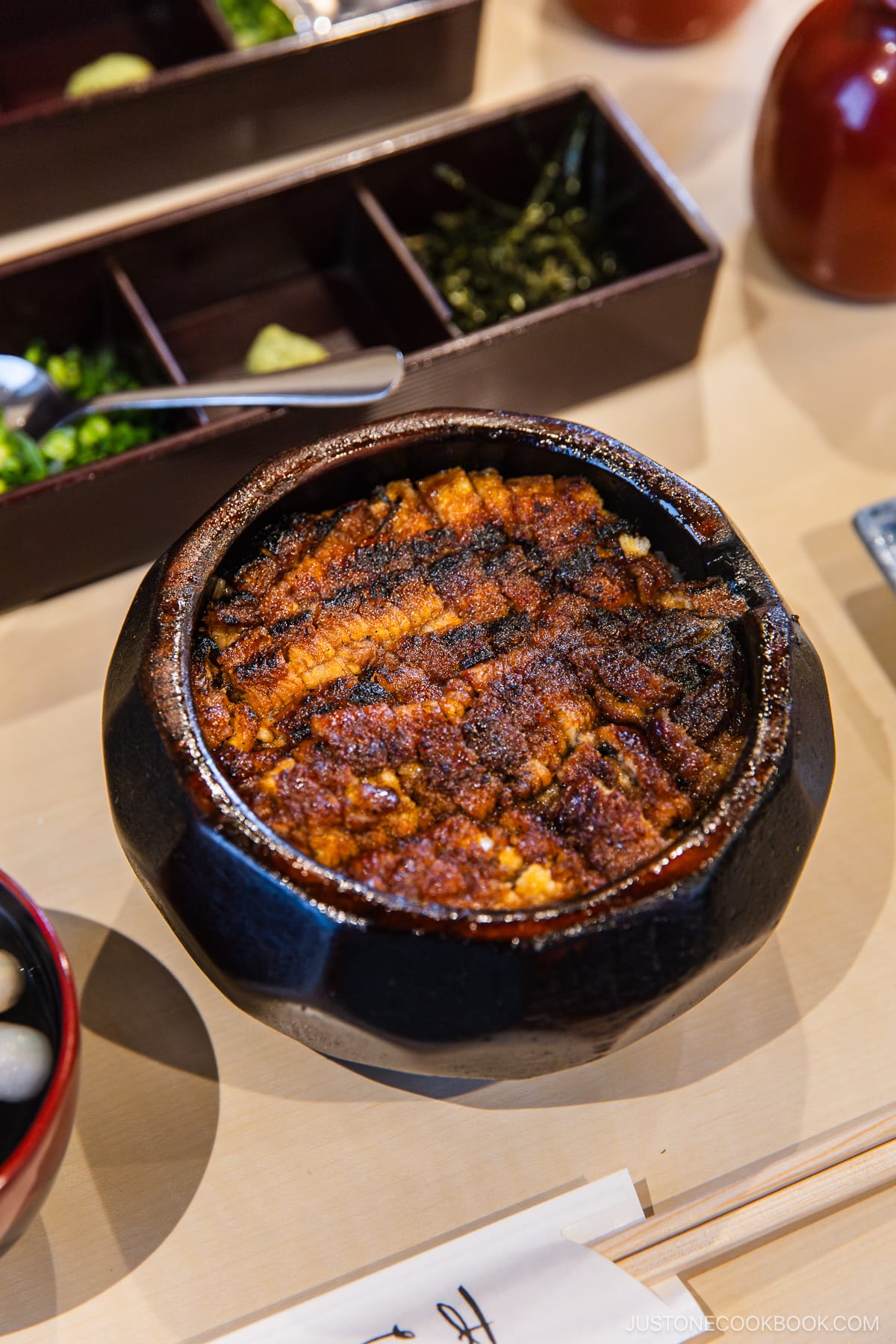
While Nagoya may not be as well known for its food compared to other cities in Japan, there is still a world full of delicious and unique dishes that will tantalize your taste buds. Local Nagoya cuisine, also known as Nagoya meshi, is filled with deep-fried dishes, noodles, sweets, and more!
Sandwiched between Osaka and Tokyo, Nagoya is a convenient city to get around Japan using the Shinkansen or by flying through Chubu Airport. So why not stop by and feast on these 10 must-try dishes?
Table of Contents
Miso Katsu (味噌カツ)
Nagoya is famed for its red miso, a variety known for its robust flavor profile, deeper hue, and increased pungency compared to white and yellow miso. Among the many types available, the most celebrated is Hatcho Miso.
This distinctive miso finds its way into various Nagoya dishes, with one standout being Miso Katsu. Here, a classic Tonkatsu (deep-fried pork cutlet) is enrobed in a rich, umami-laden red miso sauce, rendering it irresistibly flavorful. Instead of the traditional brown tonkatsu sauce, the red miso offers a bolder punch and depth of flavor, pairing perfectly with the pork.
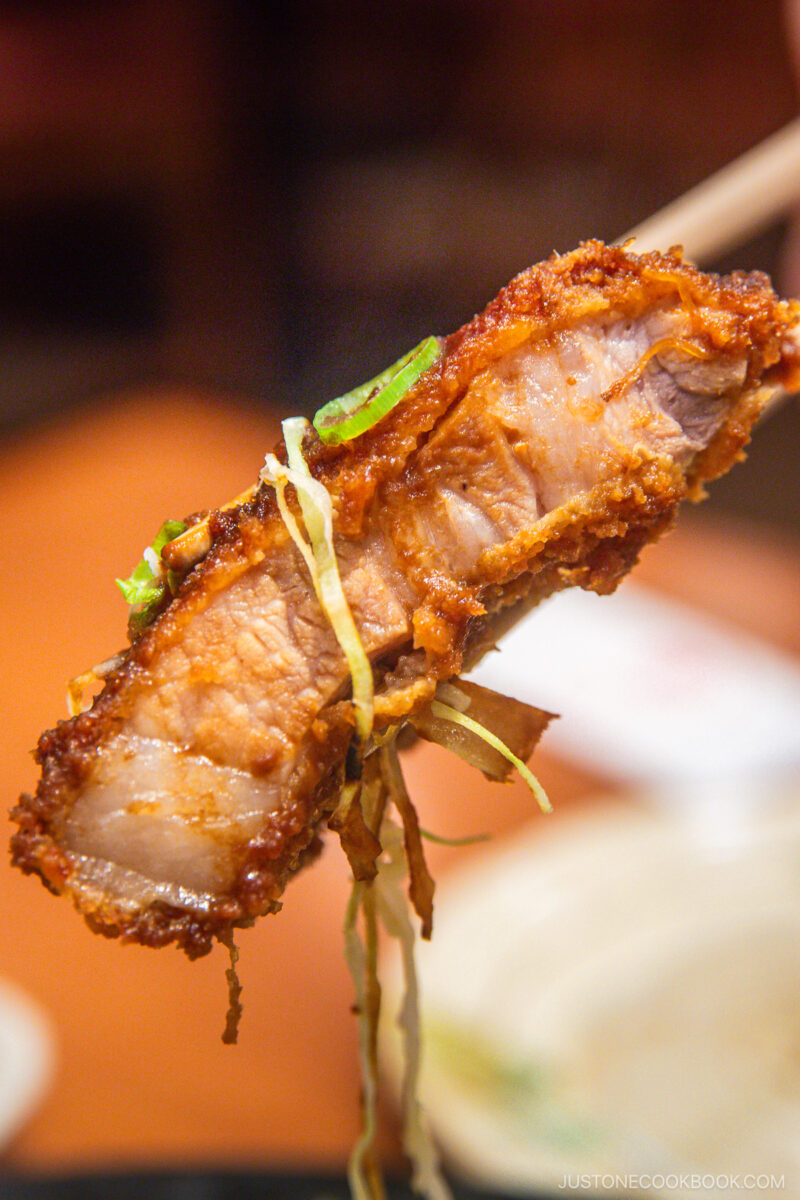
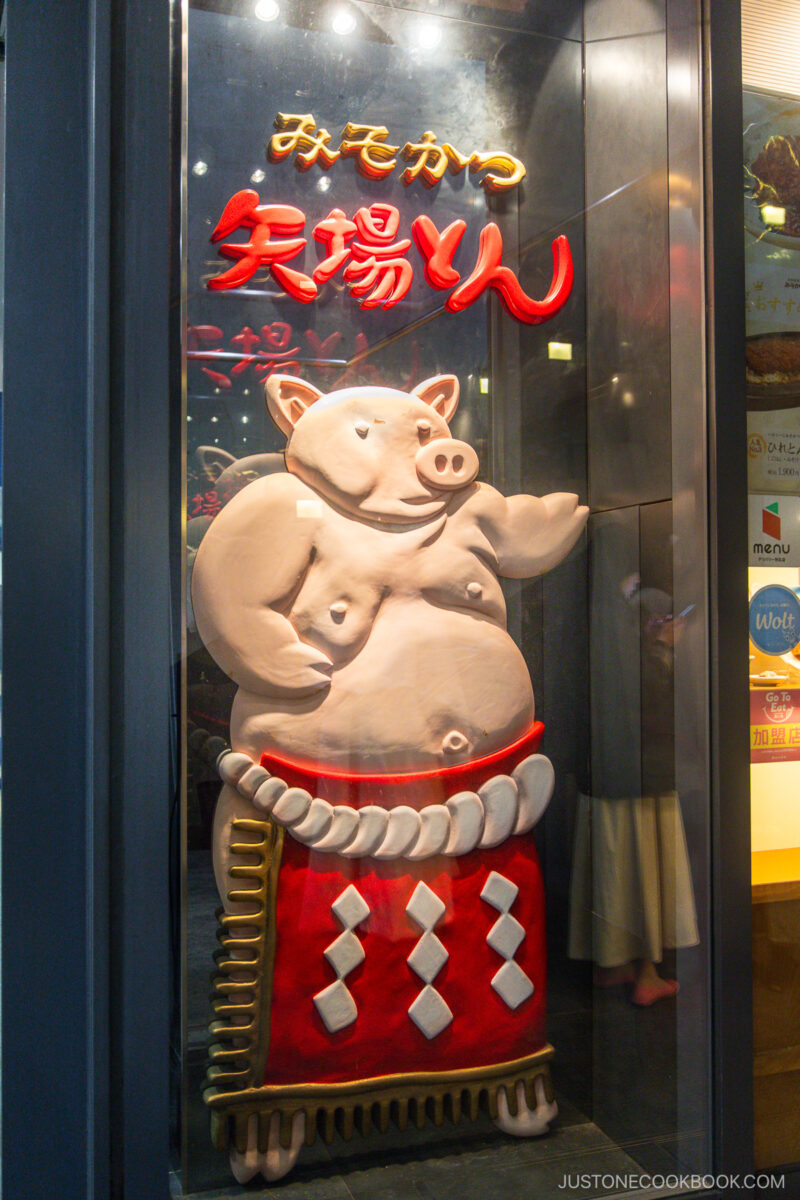
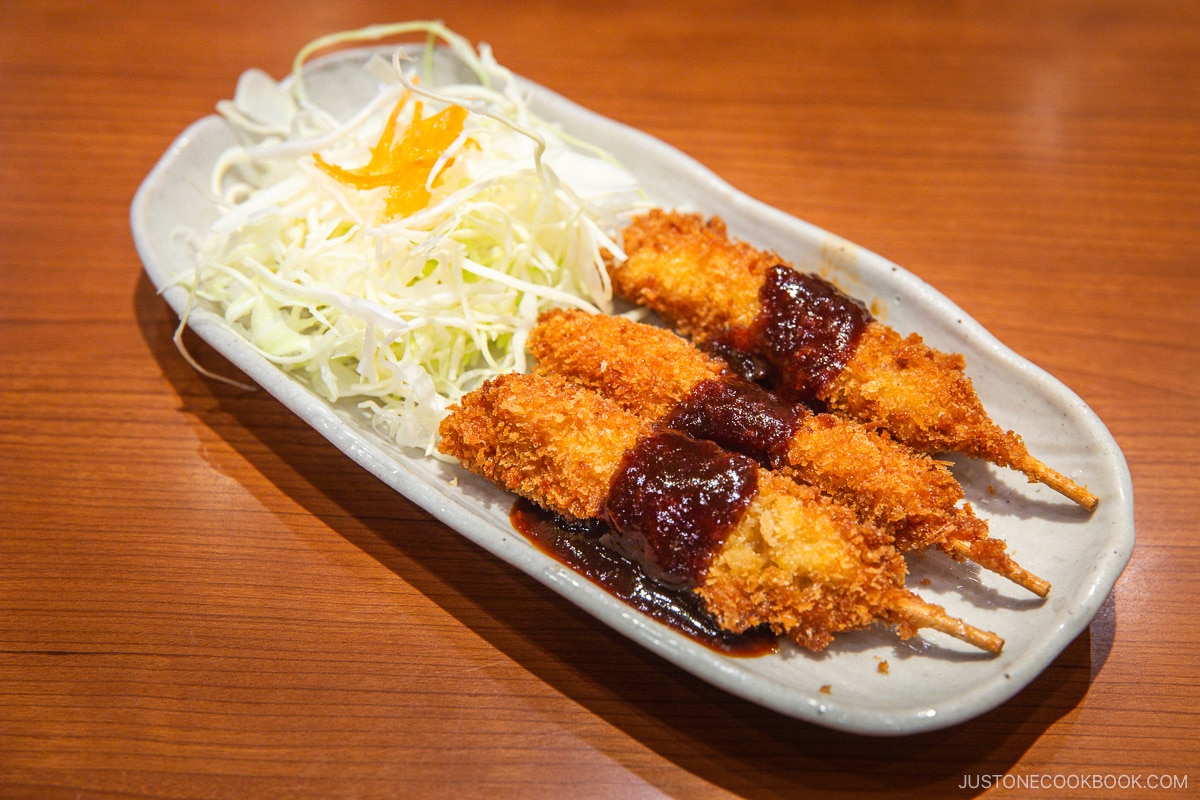
While Hatcho Miso is commonly used, Misokatsu Yabaton uses an original recipe featuring naturally brewed soybean miso aged for a year and a half. Upon ordering, the miso katsu arrives in a sizzling cast iron skillet, accompanied by thinly sliced cabbage, rice, and a side of red miso soup. Known as one of Nagoya’s quintessential dishes, this miso katsu is a must-try.
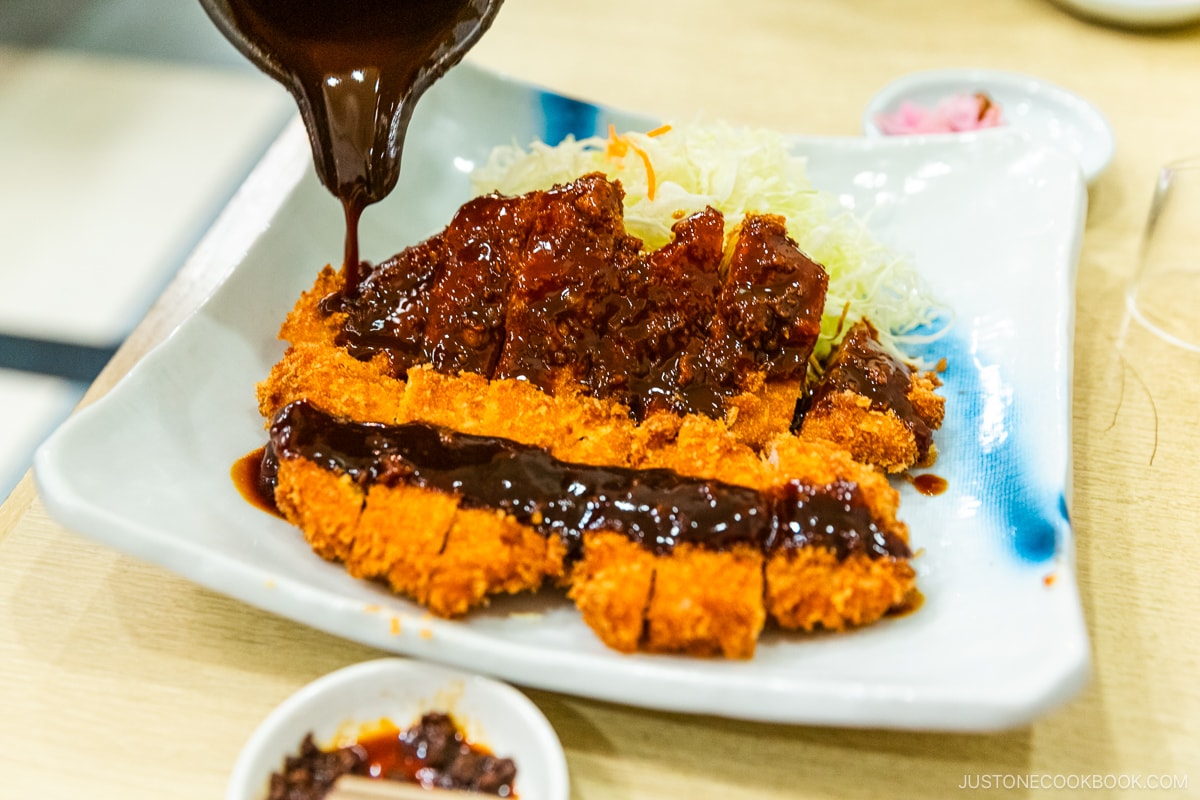
The staff will douse their special miso sauce (a mix of original miso and pork stock) on top of the pork cutlet for you so it coats each and every bite.
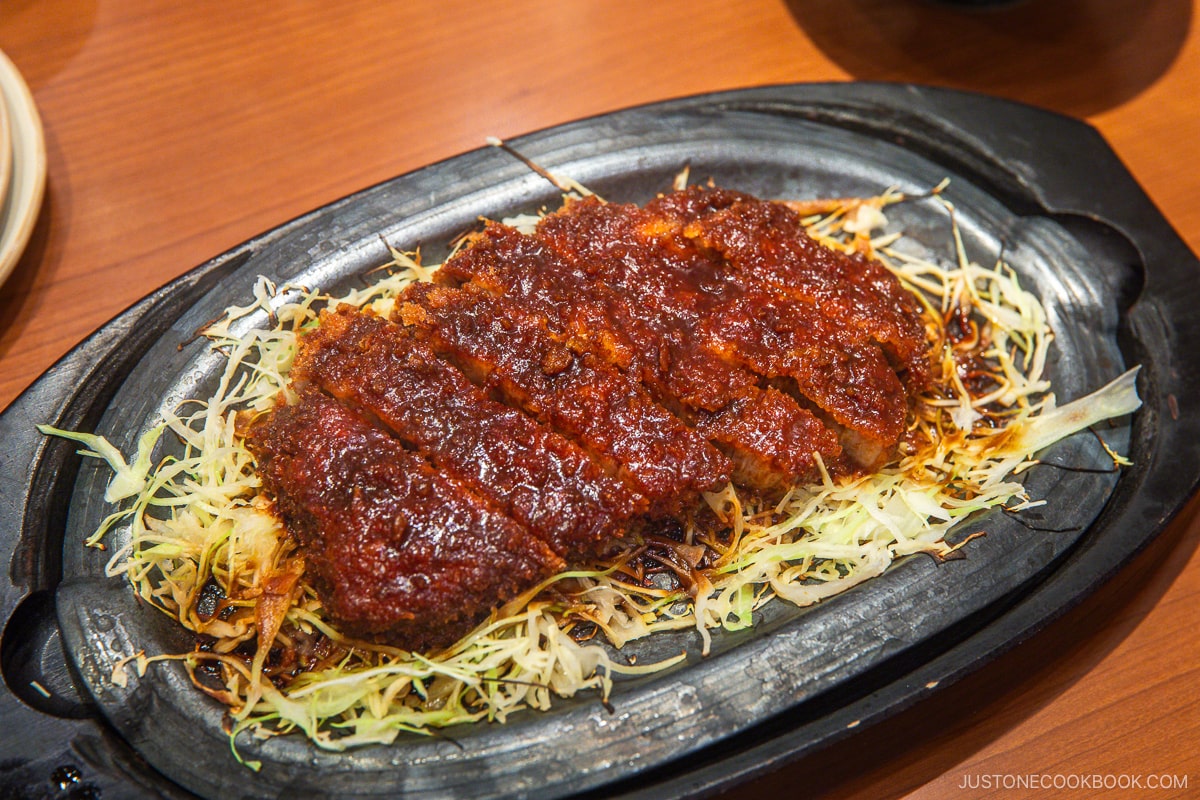
The red miso does pack a strong punch of flavor, but the sauce strikes a balance of sweetness and sharpness, perfectly complementing the richness of the pork cutlet and leaving you craving bite after bite. Paired with a bowl of rice, it’s an unbeatable combination. If you’re a fan of traditional tonkatsu, then Miso Katsu belongs at the top of your list.
To make Miso Katsu at home, check out our recipe here!
Hitsumabushi (ひつまぶし)
Next up on the list is Hitsumabushi, one of Nagoya’s most famous delicacies, consisting of grilled eel on top of a bowl of rice. The dish derives its name from ‘Ohitsu,’ a wooden container traditionally used to serve rice, and ‘mabushi,’ which refers to the action of placing the eel on top of the rice.
This is not to be confused with Unadon, which is very similar. In Hitsumabushi, the eel is grilled kabayaki-style until the skin crisps and the flesh becomes succulent and tender, then it’s generously slathered with a sweet soy sauce-based glaze. The eel is then chopped into smaller pieces and arranged on top of the rice.
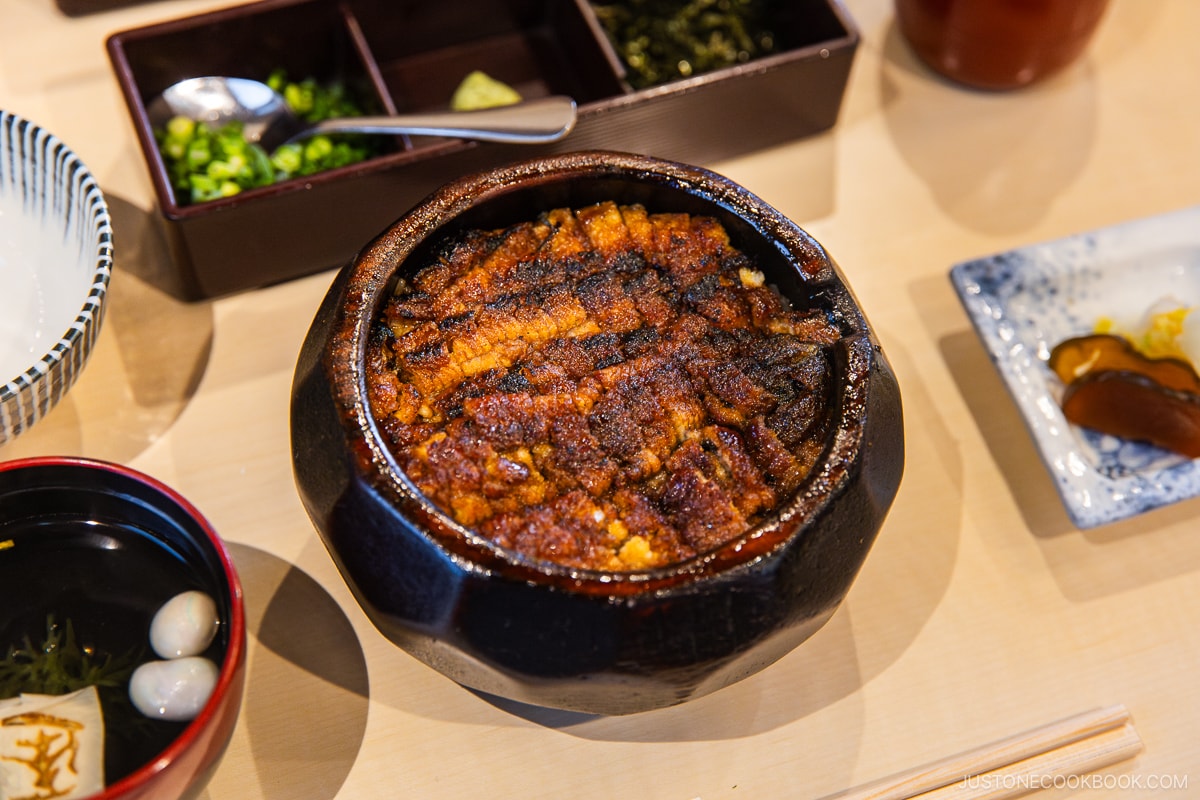
There are various origin stories surrounding Hitsumabushi. One suggests that poor-quality eel was chopped up for easier consumption, and another claims that the offcuts were used to avoid wasting any part of the eel. While we may not know which origin is 100% accurate, what we do know is that Hitsumabushi is undeniably delicious.
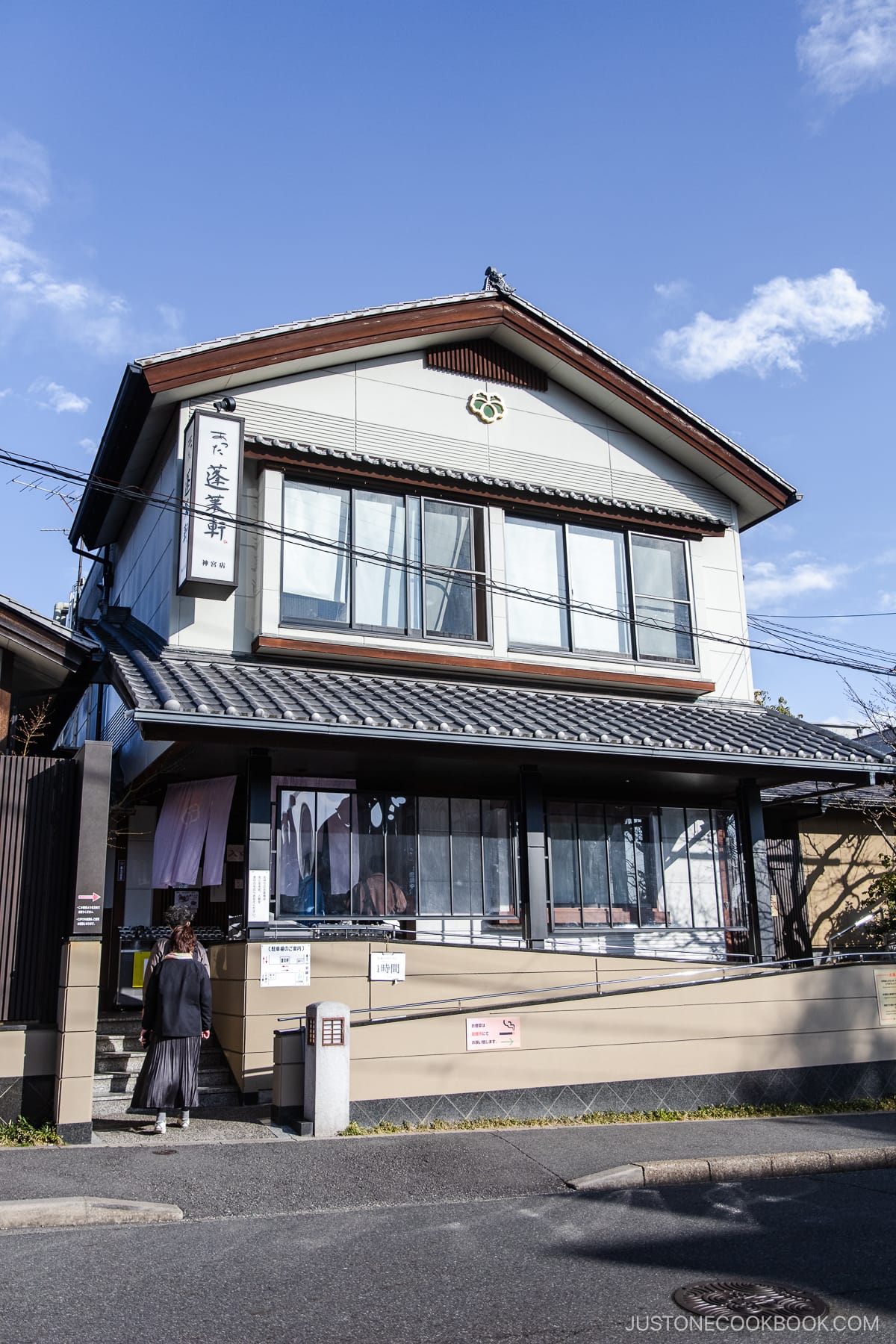
Next to Atsuka Jingu, has been serving Hitsumabushi since 1873 and has even trademarked the name! The eel is grilled while being doused with the shop’s original sauce, which has been passed down since its opening, and placed on top of a generous portion of rice. It is accompanied by some negi, wasabi, nori, pickles, dashi, and soup.
Located next to Atsuta Jingu, Atsuta Horaiken has been serving Hitsumabushi since 1873 and has even trademarked the name! The eel is grilled while being doused with the shop’s original sauce, a recipe that has been passed down since its opening, and then placed on top of a generous portion of rice. It is accompanied by negi (green onions), wasabi, nori (seaweed), pickles, dashi, and soup.
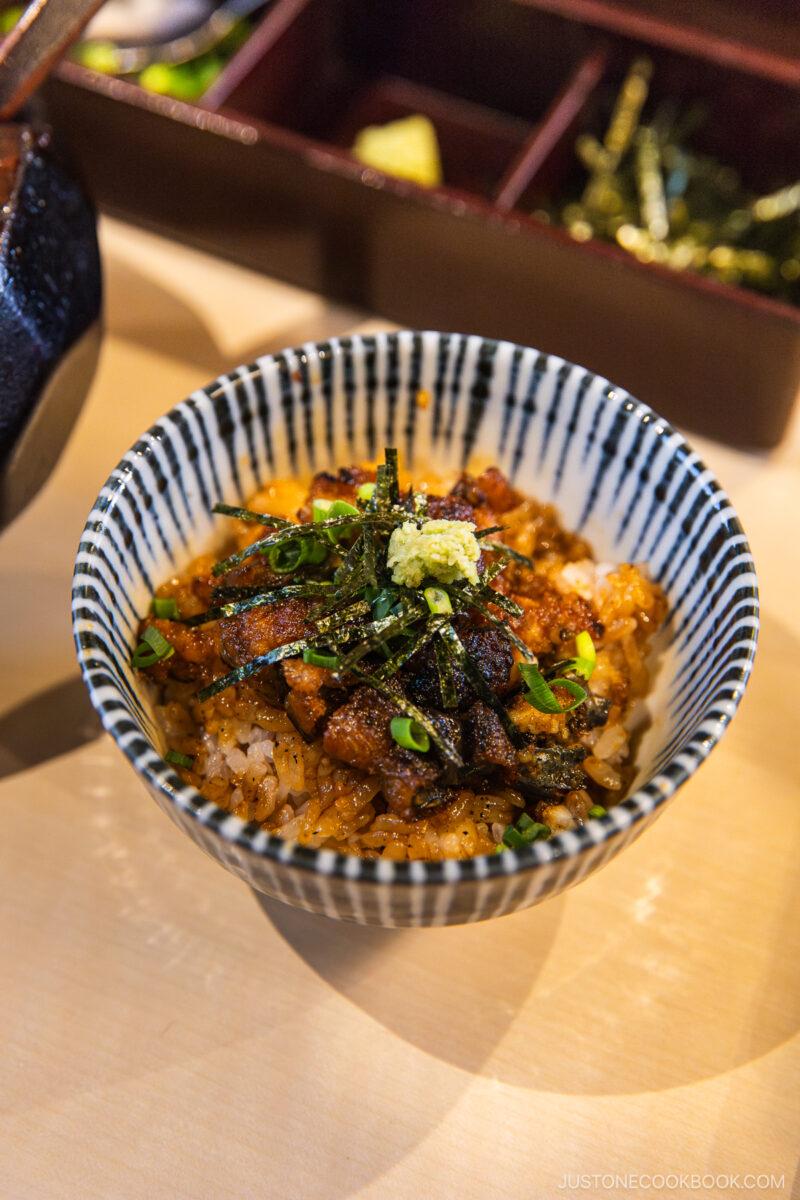
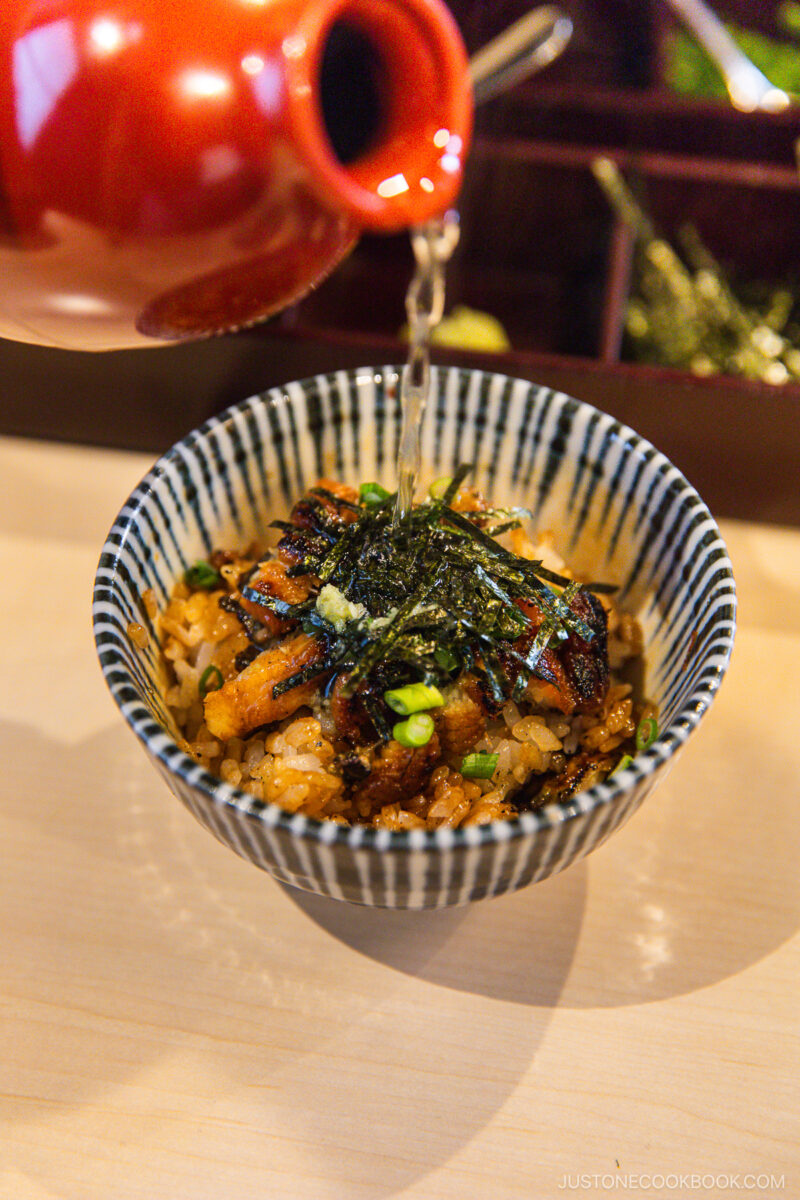
How to Eat Hitsumabushi
These condiments are provided so you can enjoy the dish in four different ways:
1. Use the wooden spoon to portion the Hitsumabushi into quarters and scoop it into the small rice bowl. Eat the first portion as is, then savor the flavor of the eel on its own.
2. For the second portion, add a little negi, wasabi, and seaweed.
3. For the third portion, add negi, wasabi, nori, and pour in the dashi broth to enjoy it as ochazuke.
4. Finally, enjoy the last quarter with your preferred method.
The portion is generous, yet surprisingly light and easy to eat. The crispiness of the eel skin, the tenderness of the flesh, and the salty-sweet sauce—everything hits just the right spot. All this for 4900 yen (as of 2024)!
Tebasaki (手羽先)
Tebasaki, or chicken wings, became popular after a customer requested fried chicken with sauce at a small restaurant called Furaibo. It proved to be a hit, prompting the owner, Mr. Otsubo, to research the perfect sauce and chicken combination. Now, Furaibo can be found all over Nagoya, and Tebasaki has become one of the city’s best local dishes.
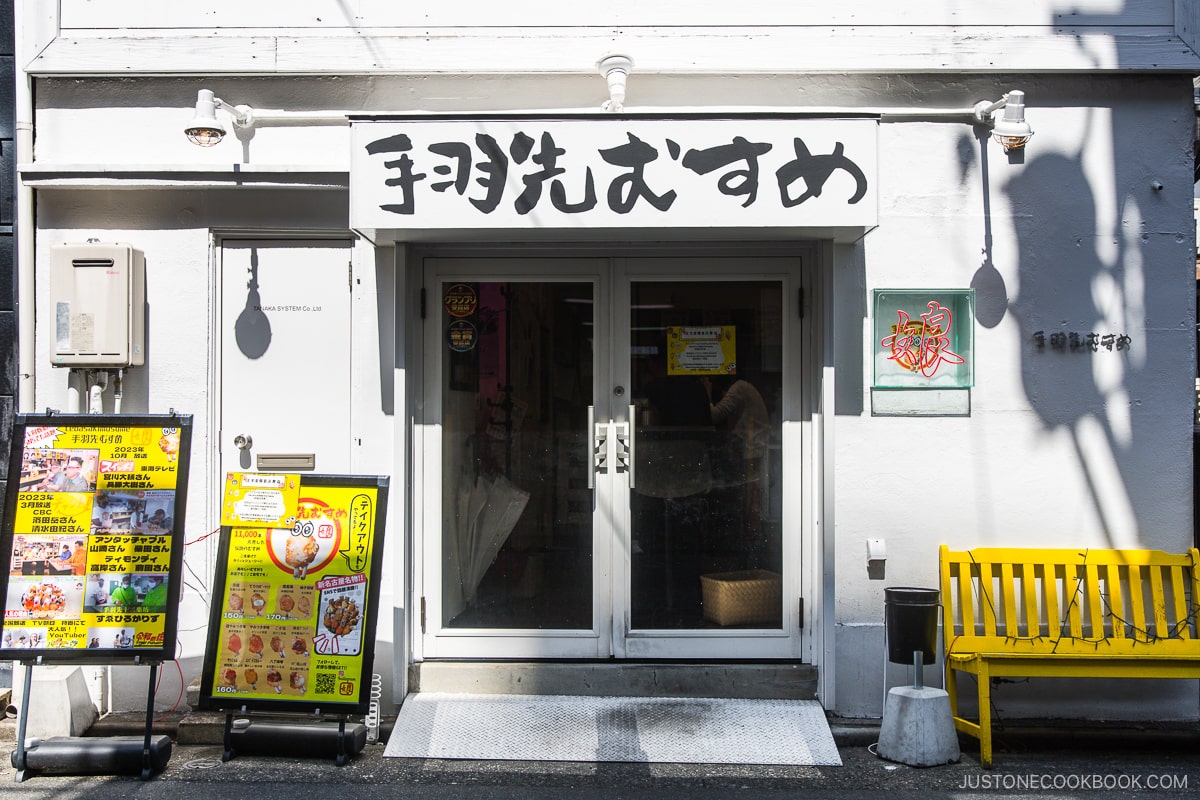
Even though Furaibo is an obvious choice, we decided to visit a smaller shop called Tebasaki Musume in Osu. During the “Tebasaki Summit 2022,” Tebasaki Musume sold 11,000 wings in three days and was subsequently awarded the gold prize! Unlike traditional Tebasaki served in wing shape, they prepare theirs like drumettes so you can enjoy the wings in one bite, hassle-free!
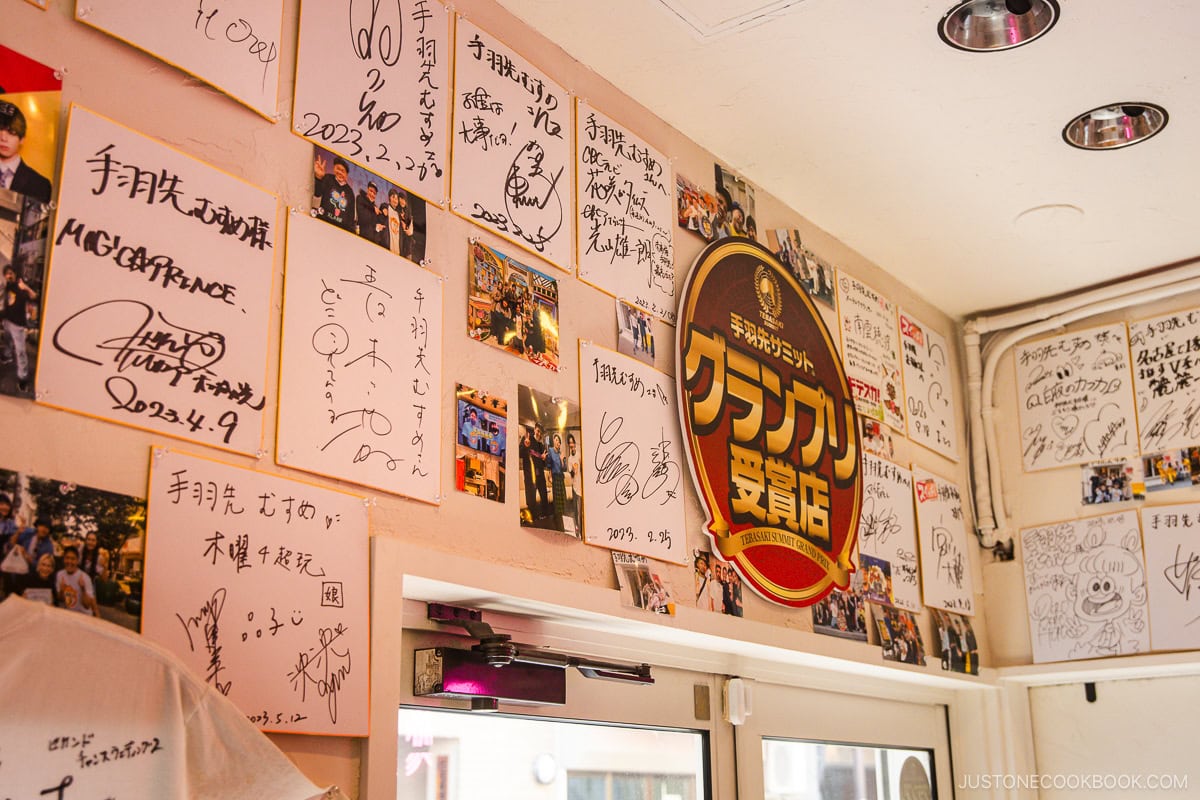
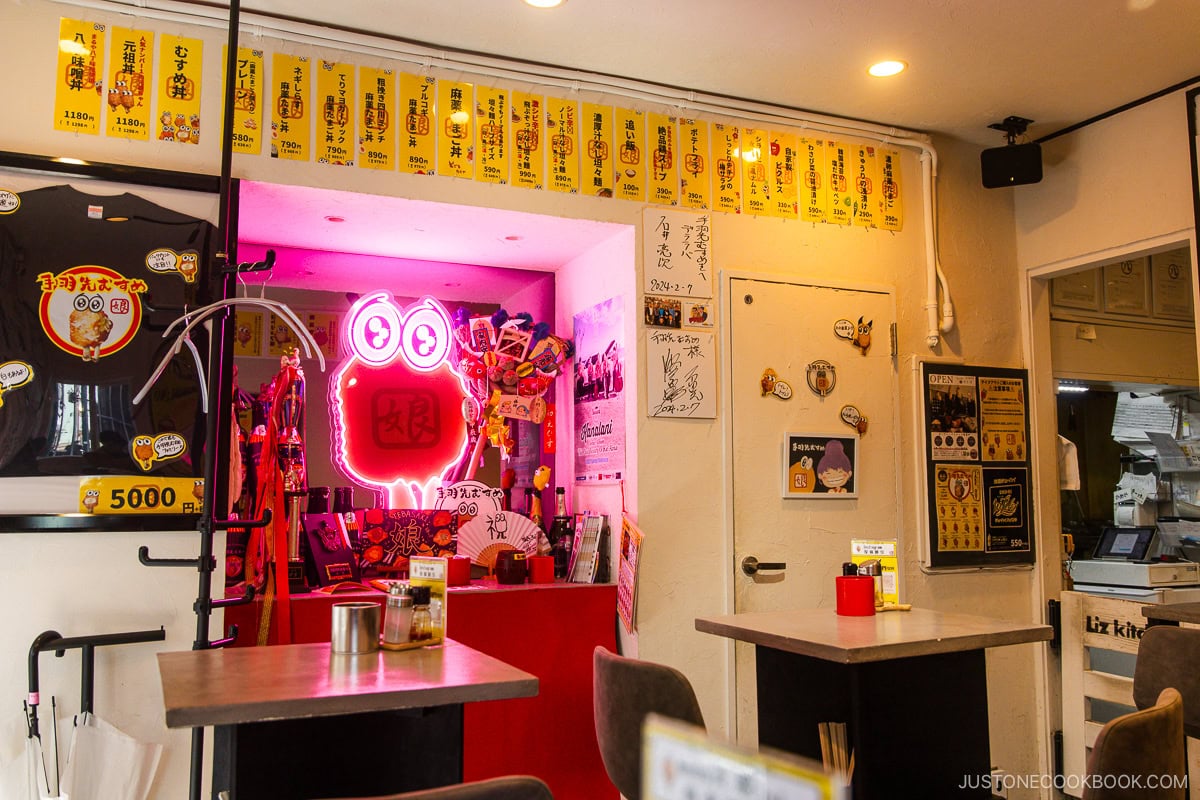
Inside the shop, you can see their 2022 prize and a host of autographs from popular Japanese personalities who have visited the shop.
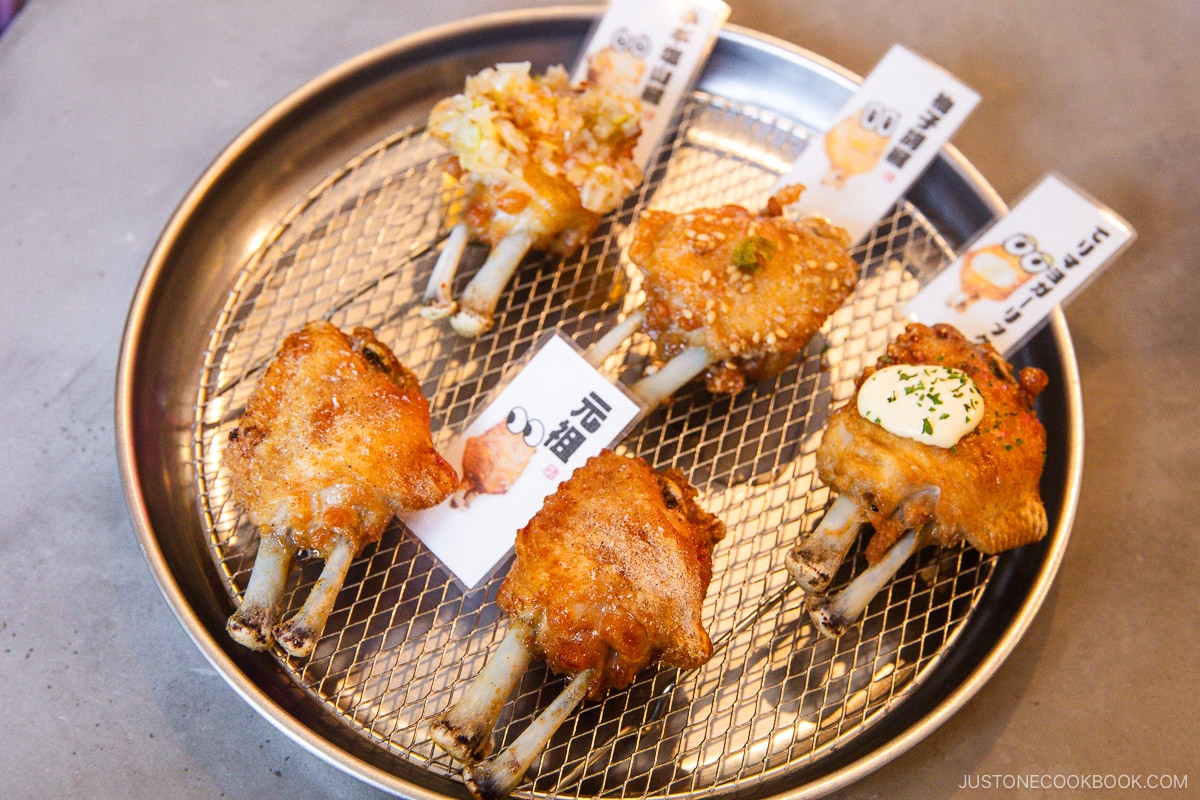
The menu has countless wings with various sauces from their original to Yuzukosho and Teri Mayo Garlic. Each one ranges from around 165 yen to 220 yen, with combination platters available to share. Alternatively, you can pick and choose whichever flavor suits you.
The menu offers countless wings with various sauces, ranging from their original to Yuzukosho and Teri Mayo Garlic. Each one is priced between 165 yen and 220 yen, with combination platters available for sharing. Alternatively, you can pick and choose whichever flavor suits you.
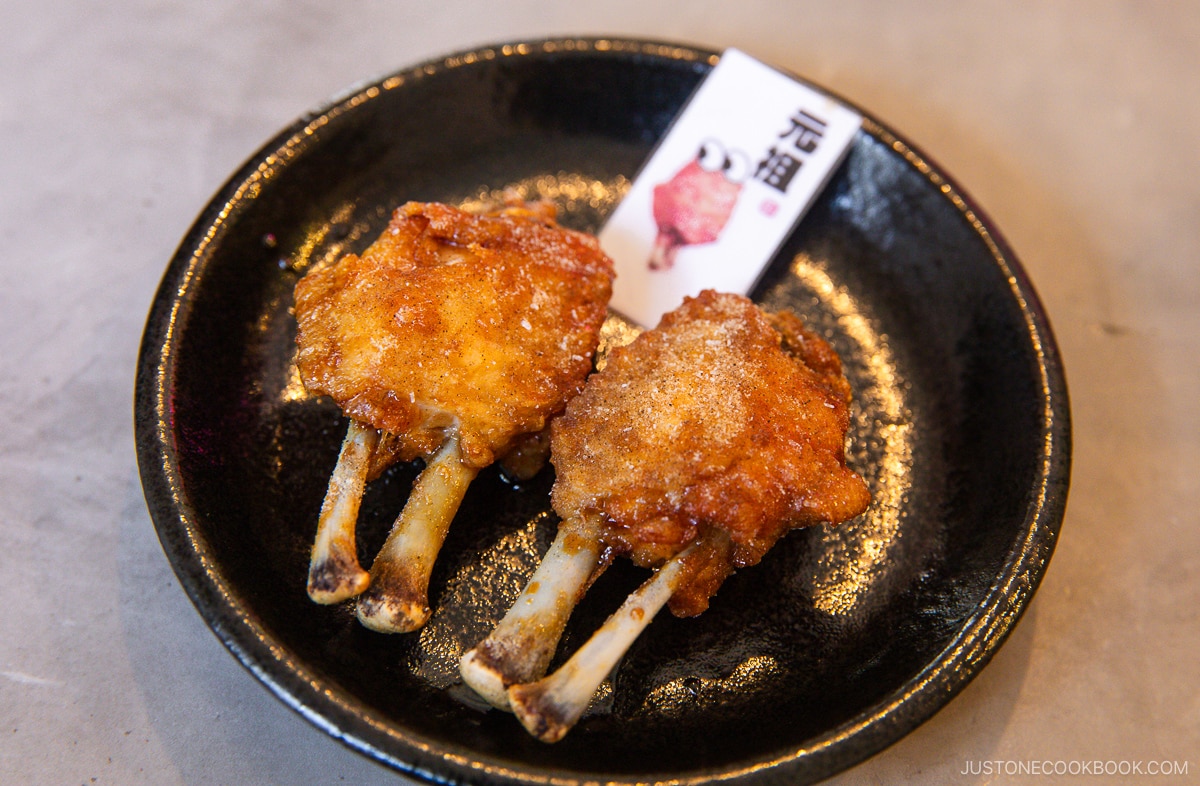
The Tebasaki are slowly deep-fried until slightly crisp on the outside and juicy on the inside. We couldn’t get enough of them and had to order more before leaving! The restaurant is small, seating around 10-15 people, creating a cozy yet lively atmosphere. We definitely want to go back there for more wings and drinks!
Another popular Nagoya chicken wings chain you’ll see in many parts of Japan is Sekai no Yamachan. If you haven’t had a chance to visit Nagoya, we recommend trying it in other cities.
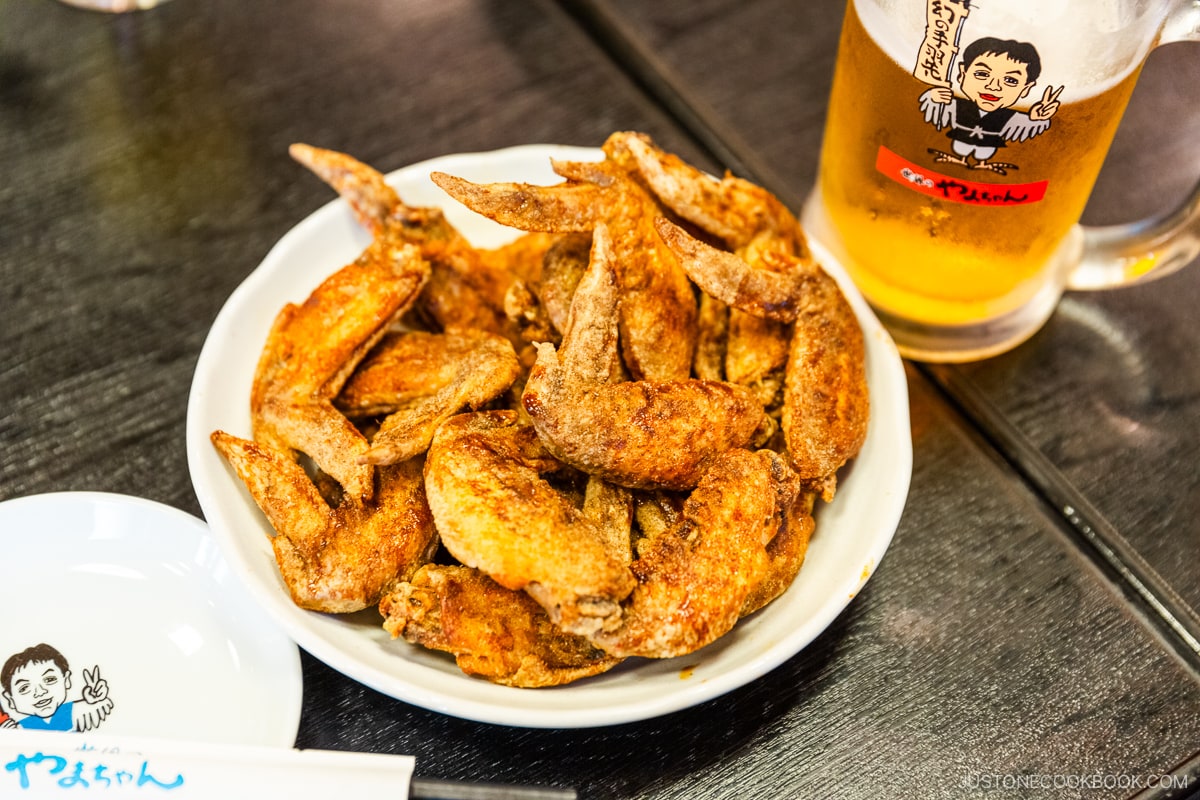
Miso Oden (味噌おでん)
If you’re visiting Nagoya in the colder months, then you must try their oden! Oden is a classic winter dish that provides all the nutrients and vitamins you need during the cold months. Oh, and it’s also delicious! It’s made by simmering various vegetables and meats, such as daikon radish, hard-boiled egg, and beef tendons, in a dashi broth. Add some red miso paste, and you’ll have a Nagoya classic!
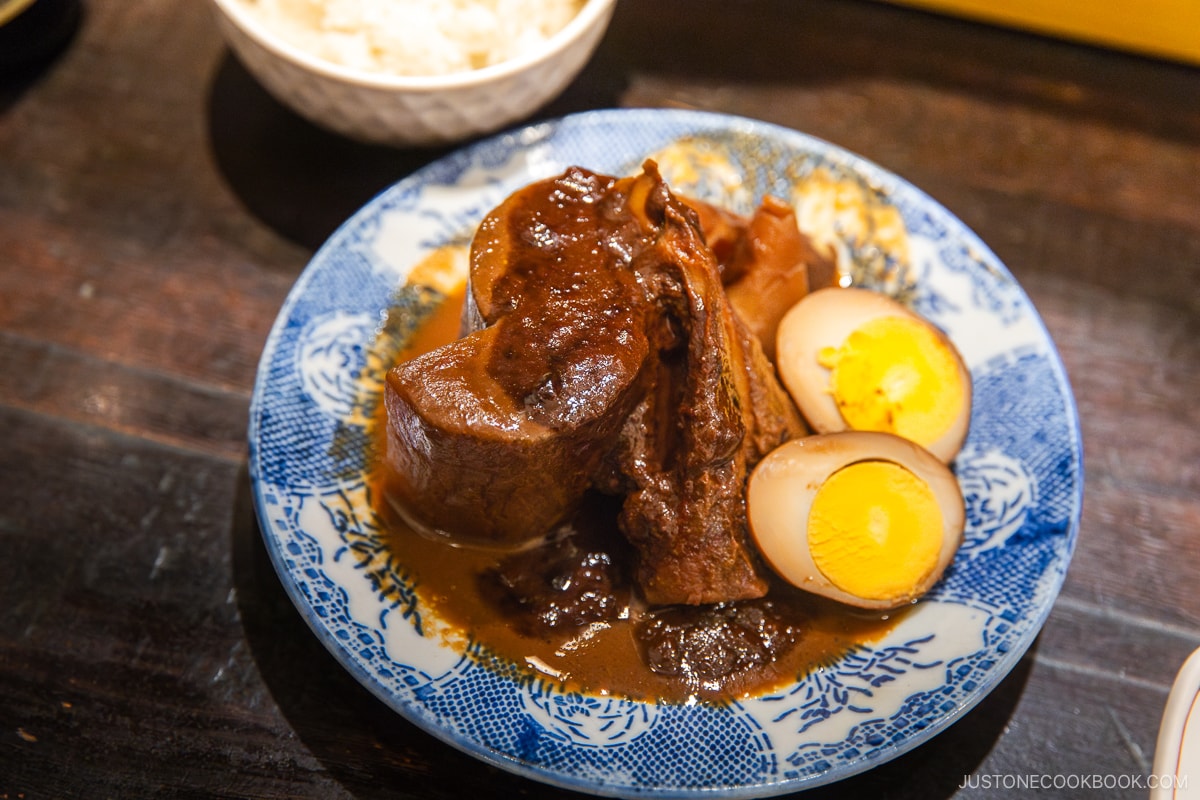
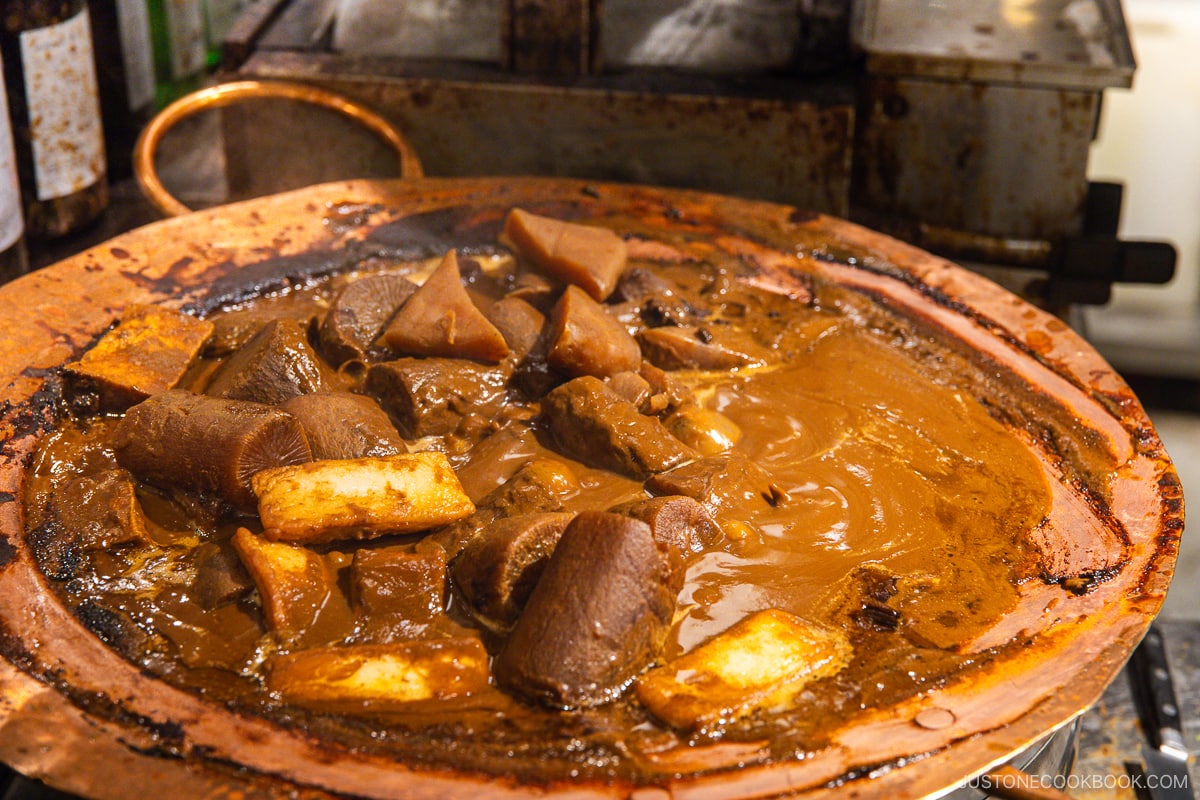
In some restaurants, the dashi-simmered ingredients are topped with red miso, while in other places, the ingredients are simmered in a red miso broth. This style allows the deep flavors of the miso to soak into each ingredient, pairing perfectly with some rice and a beer. It’s no wonder you can find it in many izakayas around the city!
Kishimen Udon (きしめんうどん)
We can’t miss trying a local noodle dish, so this brings us to Kishimen Udon. Kishimen is a variation of traditional udon noodles made with wheat flour and slightly more concentrated salt water. Its most distinctive aspect is its flat and thin shape, unlike the round or square shape of regular udon.
This shape makes it easier for the noodles to soak up all the delicious broth, which is perfect for those who love bolder flavors. The noodles also have a slightly softer texture than regular udon, making them easier to eat.
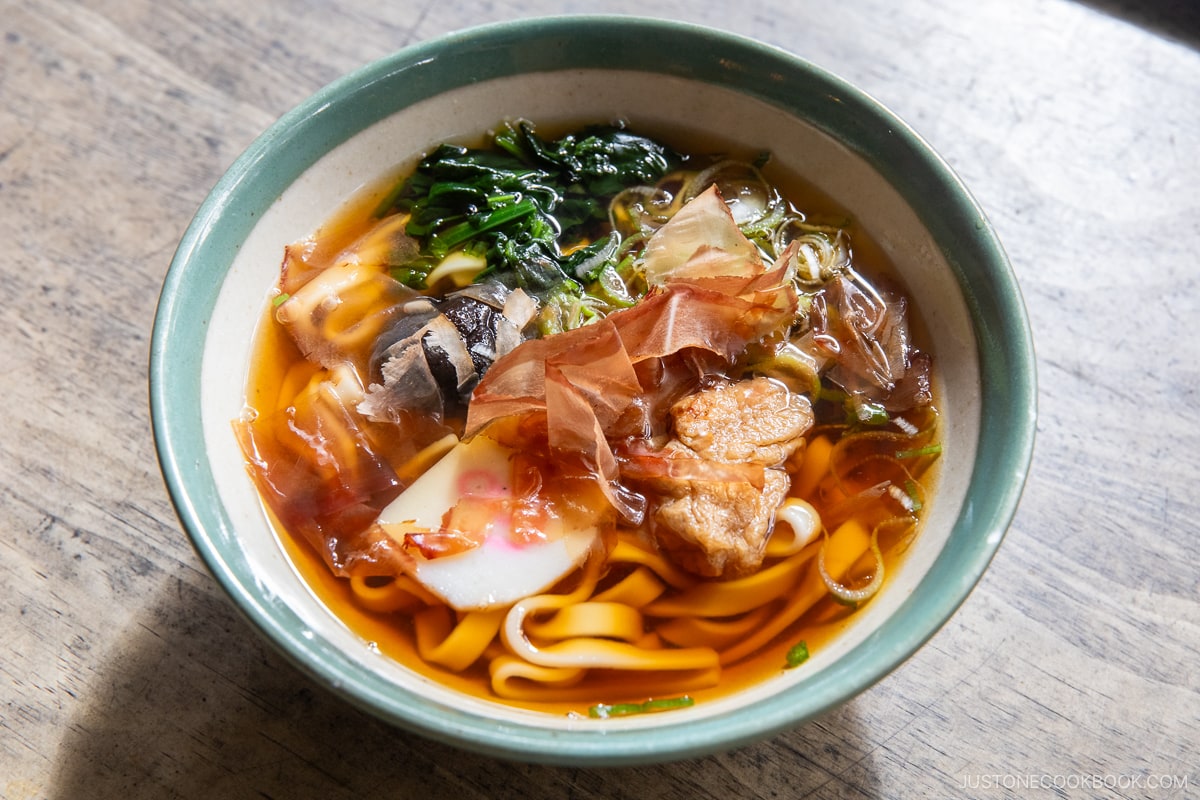
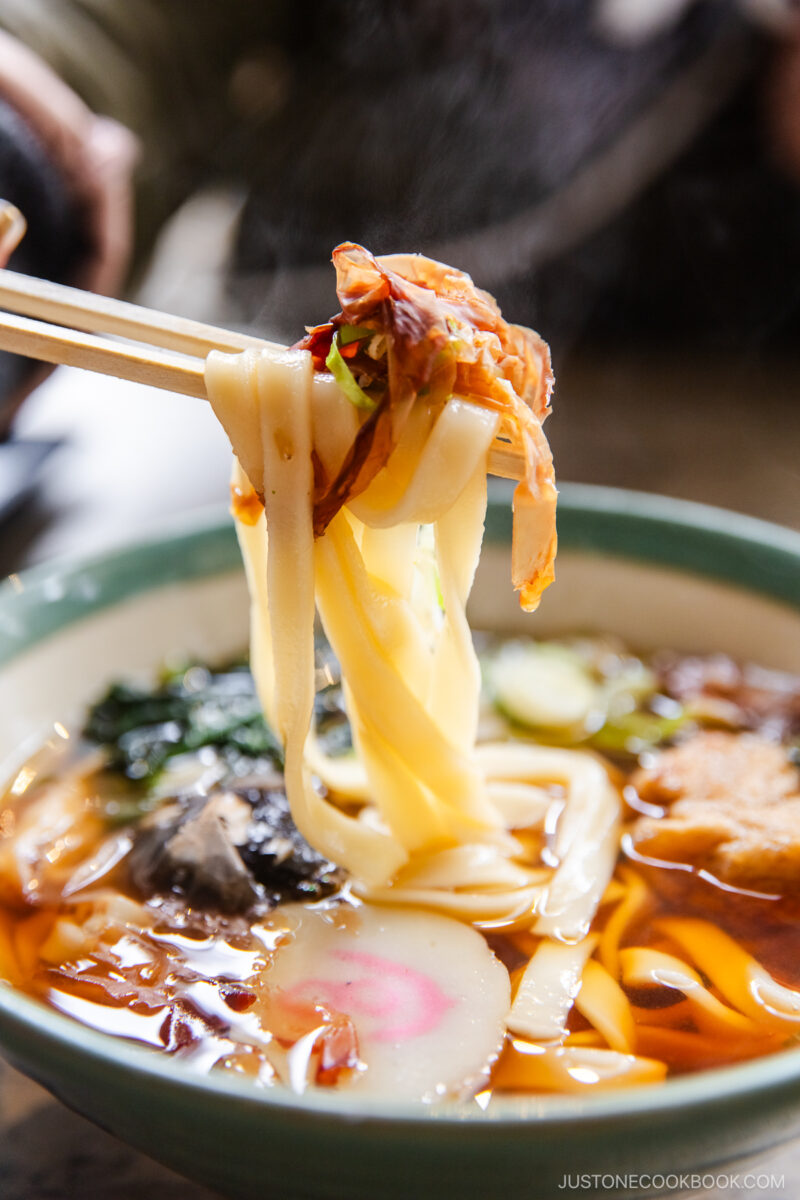
If you’re heading to Atsuta Jingu, head to Miyakishimen Jingu-ten (宮きしめん神宮店), ocated within the shrine’s grounds. They offer various types of Kishimen Udon, but the store’s classic, Miya Kishimen, comes with aburaage, pork, spinach, and shiitake mushrooms, topped with katsuobushi.
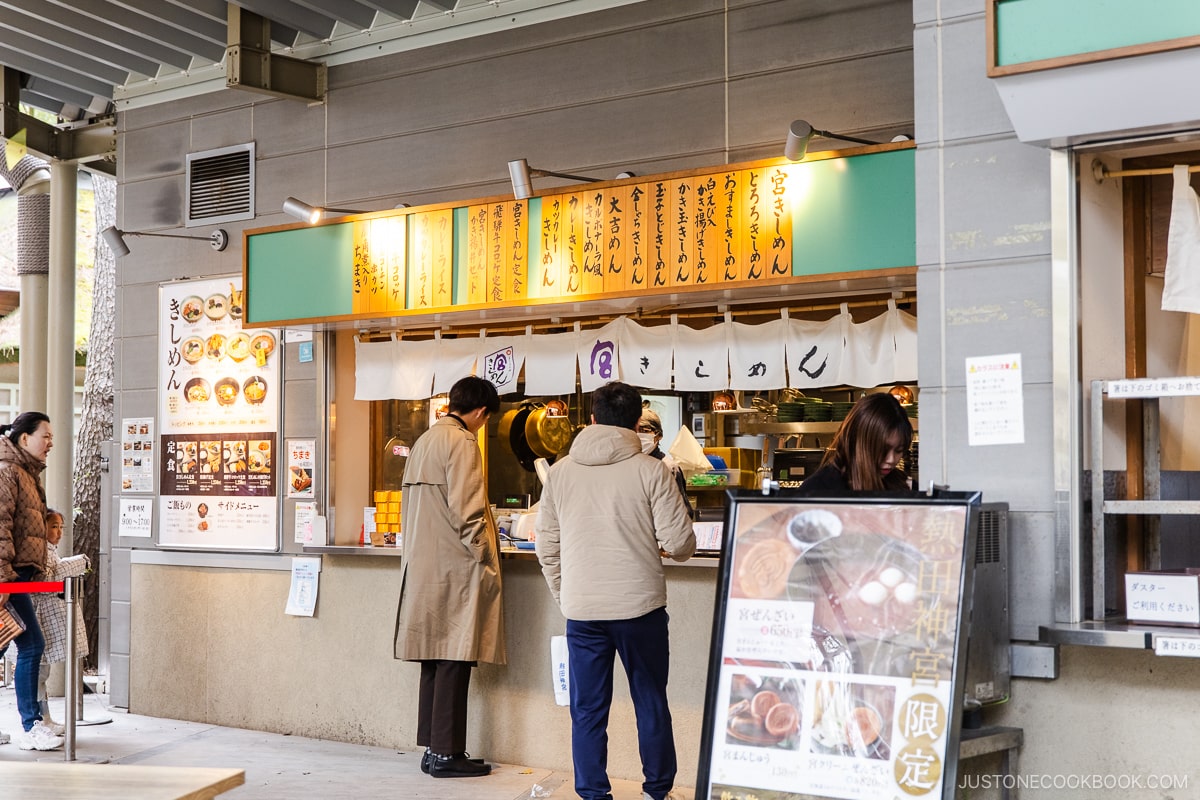
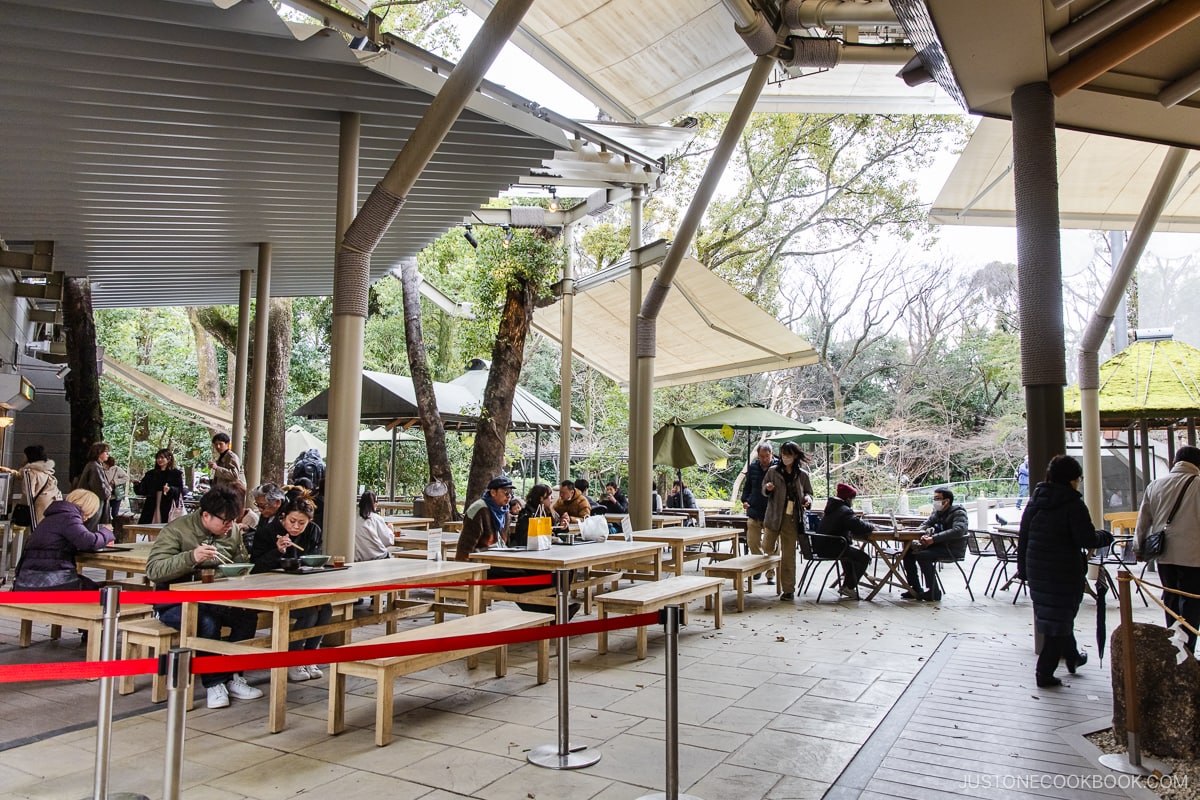
It’s a treat to relax on the shrine’s grounds with some fantastic food and incredible scenery!
Miso Nikomi Udon (味噌煮込みうどん)
Continuing from udon, another local Nagoya delicacy is Miso Nikomi Udon. Thick udon noodles are served in a red miso broth, traditionally topped with negi, kamaboko, and a raw egg. It is served in a donabe (earthenware pot) and comes out bubbling and steaming hot. The udon noodles are also boiled slightly less, giving them a firmer texture, which enhances the enjoyment of the deep-flavored broth
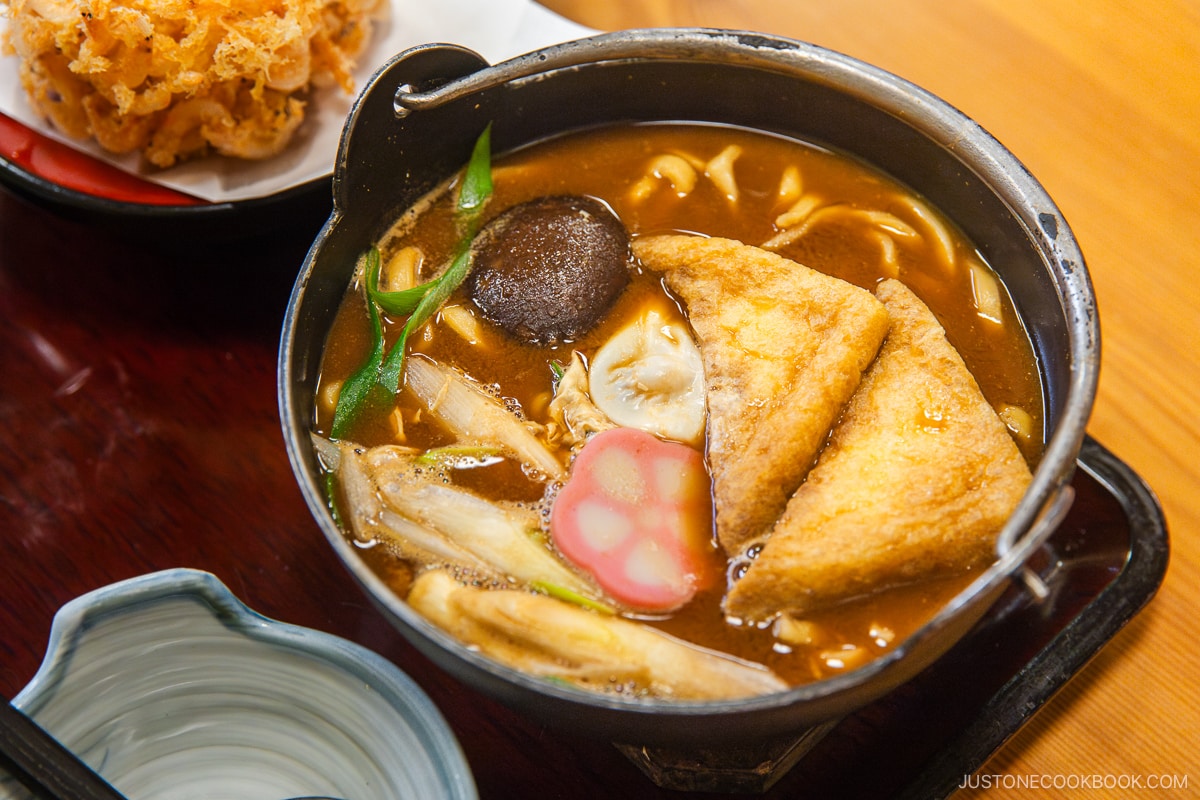
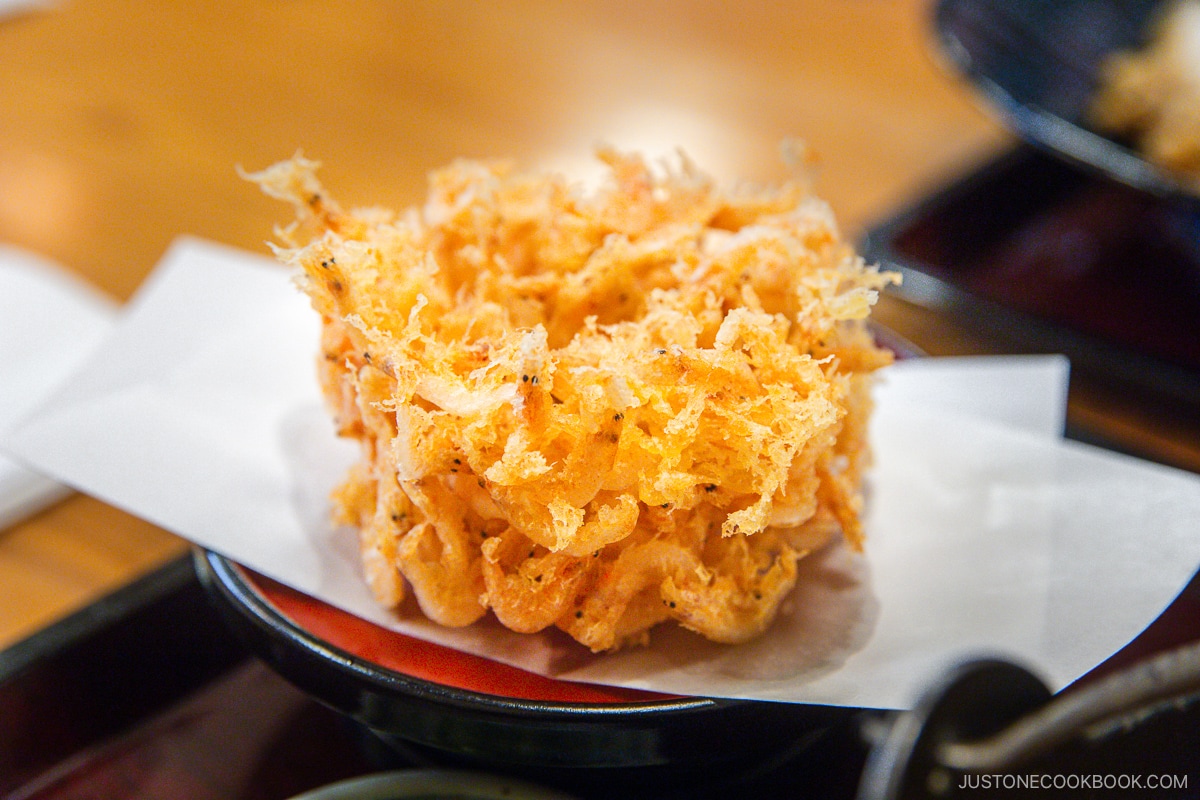
Head to Teuchimempomaruichi (手打麺舗丸一) to pick up Miso Nikomi Udon and some crisp tempura! During Sakura season, they even have some special Sakura ebi tempura on the menu! You can also upgrade your noodles to Kishimen Udon for an additional fee of 50 yen.
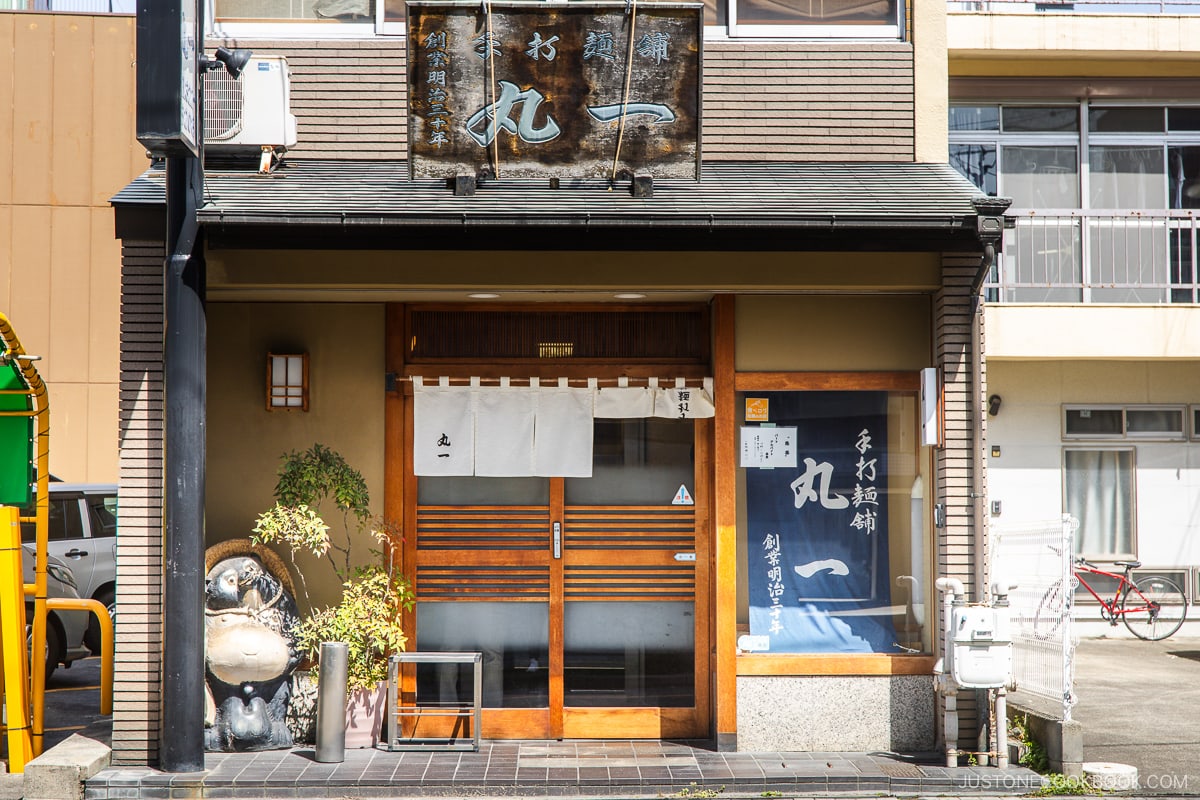
What we loved about this restaurant was that it was filled with locals. Forget about restaurants that offer every local specialty on their menus! While you might get to try a wide range of foods elsewhere, these local restaurants are where you find the real deal.
Taiwan Ramen and Abura Soba
You might be thinking, ‘Taiwan Ramen in Nagoya?’ The Taiwanese owner of Misen restaurant was serving a Taiwanese noodle dish known as Danzai Noodles (very different from those in Taiwan). He decided to create an even spicier version and called it Taiwan Ramen. And it’s not for the faint-hearted.
The noodles are immersed in a chicken bone broth with minced meat, chives, and an indescribable amount of red chili that will make you sweat. But this hot and spicy sensation took over Nagoya, and now you can find Taiwan Ramen and Misen branches across the city. We only recommend trying Taiwan Ramen if you like spice!
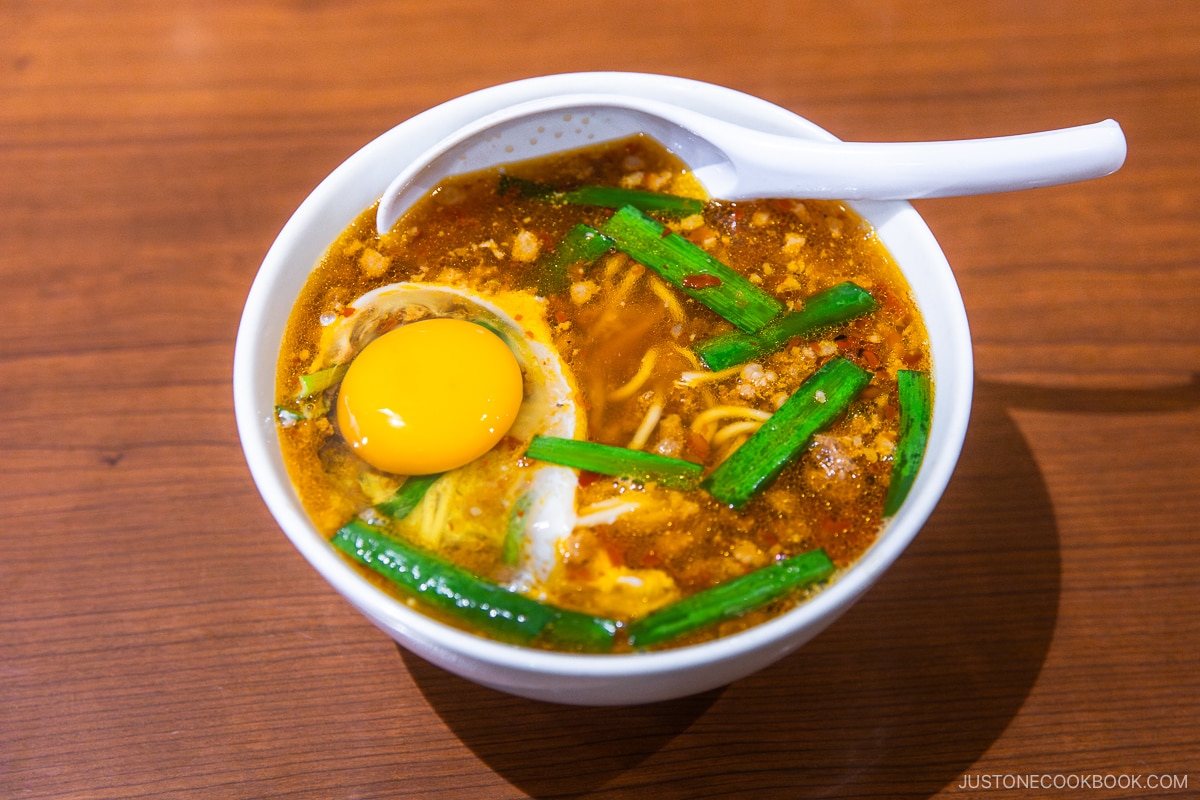
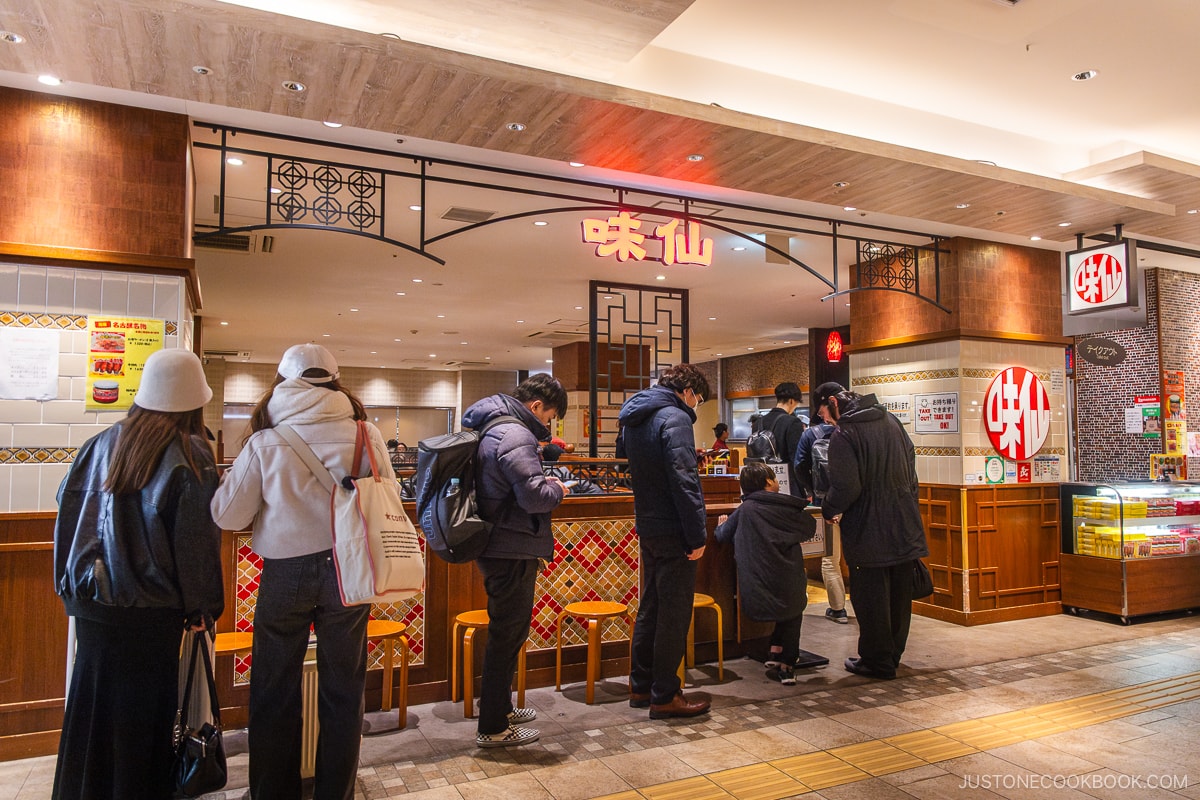
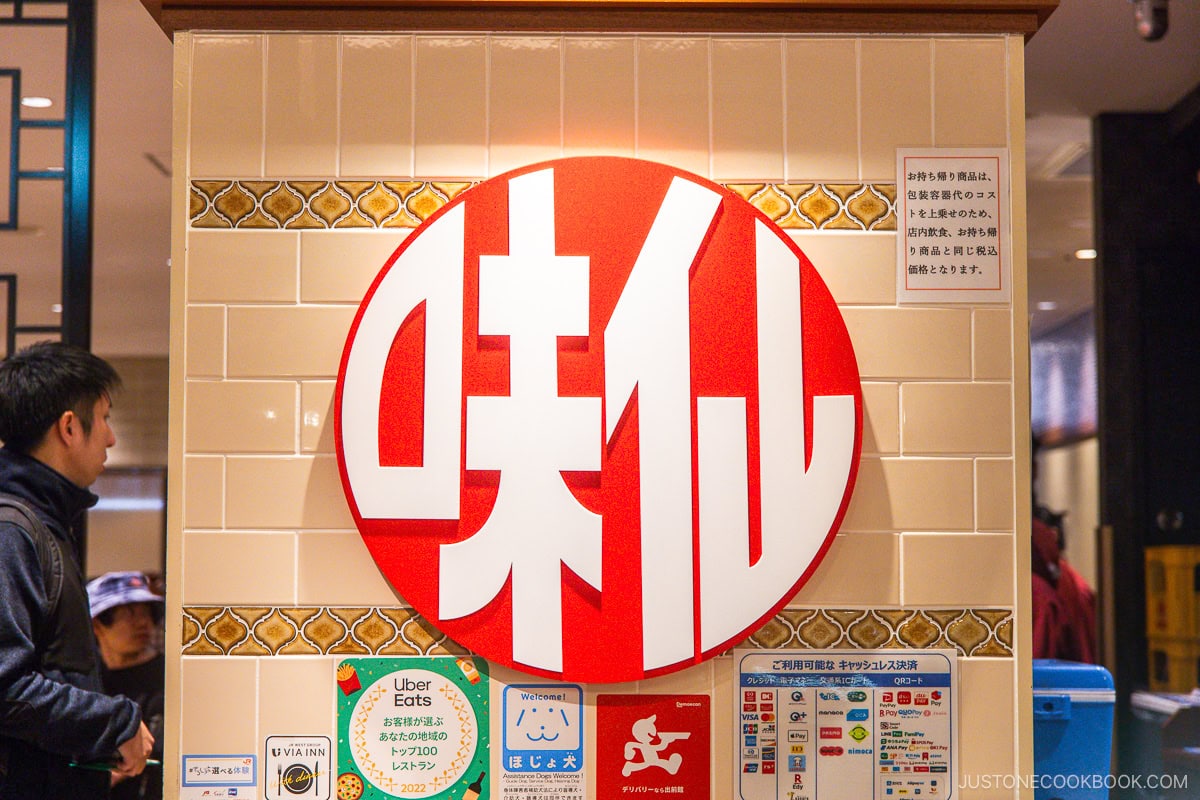
Fun fact: in Taiwan, this ramen is known as Nagoya Ramen!
Another popular Taiwan-style noodle that originated in Nagoya is abura soba. There are several popular chains including Fujiyama, Kajiken (now in California), and GINBARE55. The noodles are served dry with toppings including nori, ground pork, garlic chives, and katsuobushi. Each shop has its own secret sauce used to mix the noodles. Want to give it a try at home? Here’s Nami’s recipe.
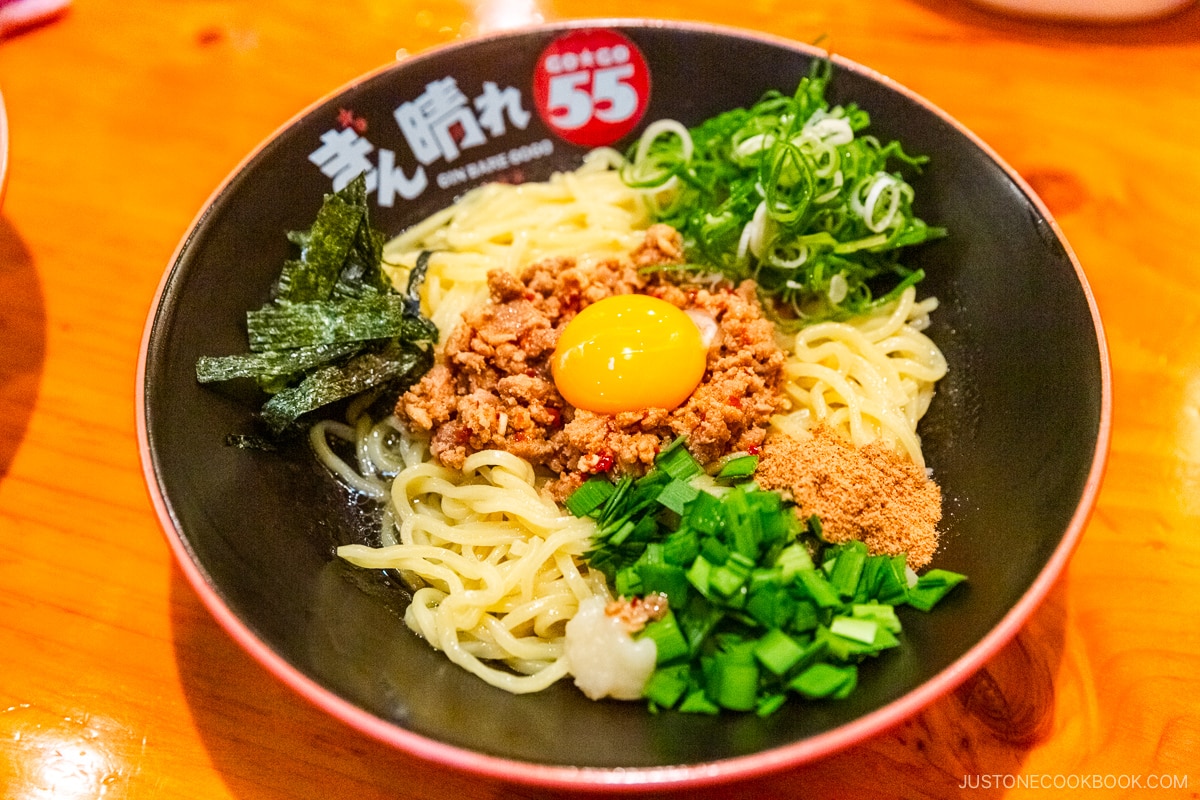
Ebi Fry (エビフライ)
Ebi Fry is deep-fried shrimp that are golden brown on the outside and Puri-puri (Japanese onomatopoeia for plump/tender) on the inside. Although available nationwide, Ebi Fry is considered a specialty in Nagoya. The city has a history of enjoying shrimp, as Mikawa Bay is renowned as one of the best shrimp fishing spots in Japan.
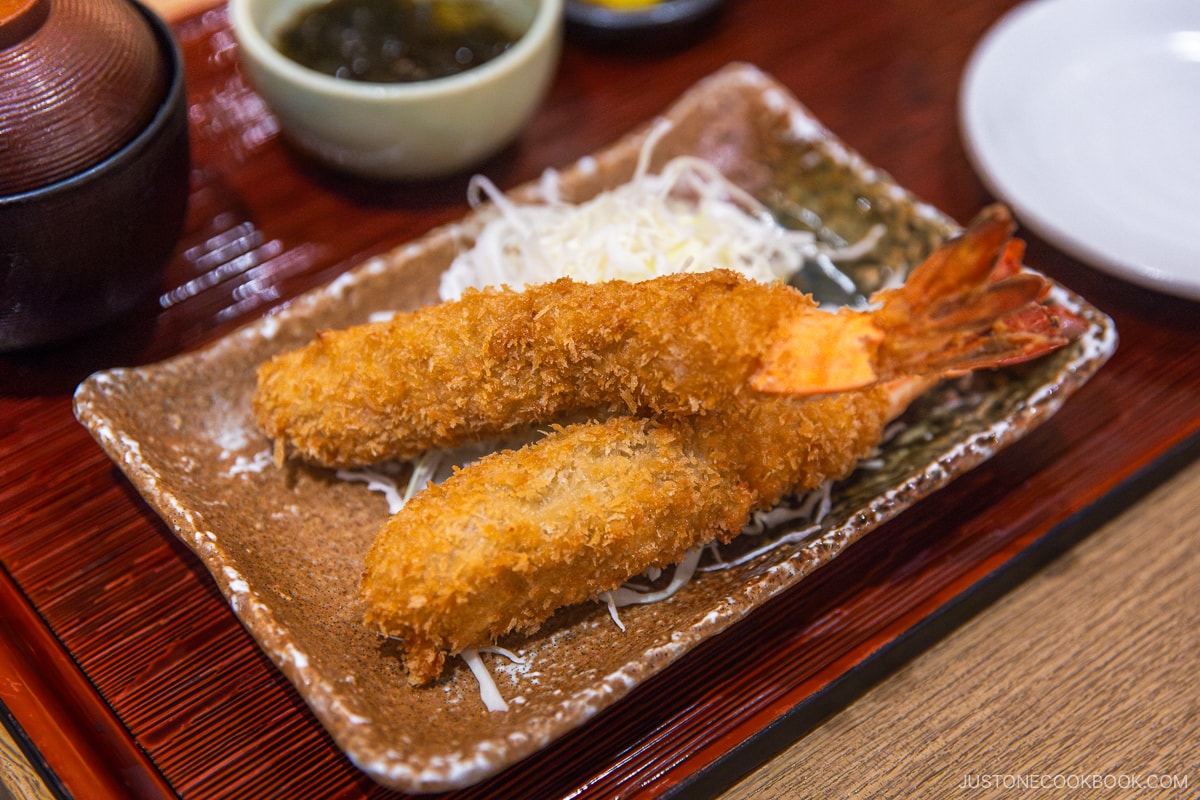
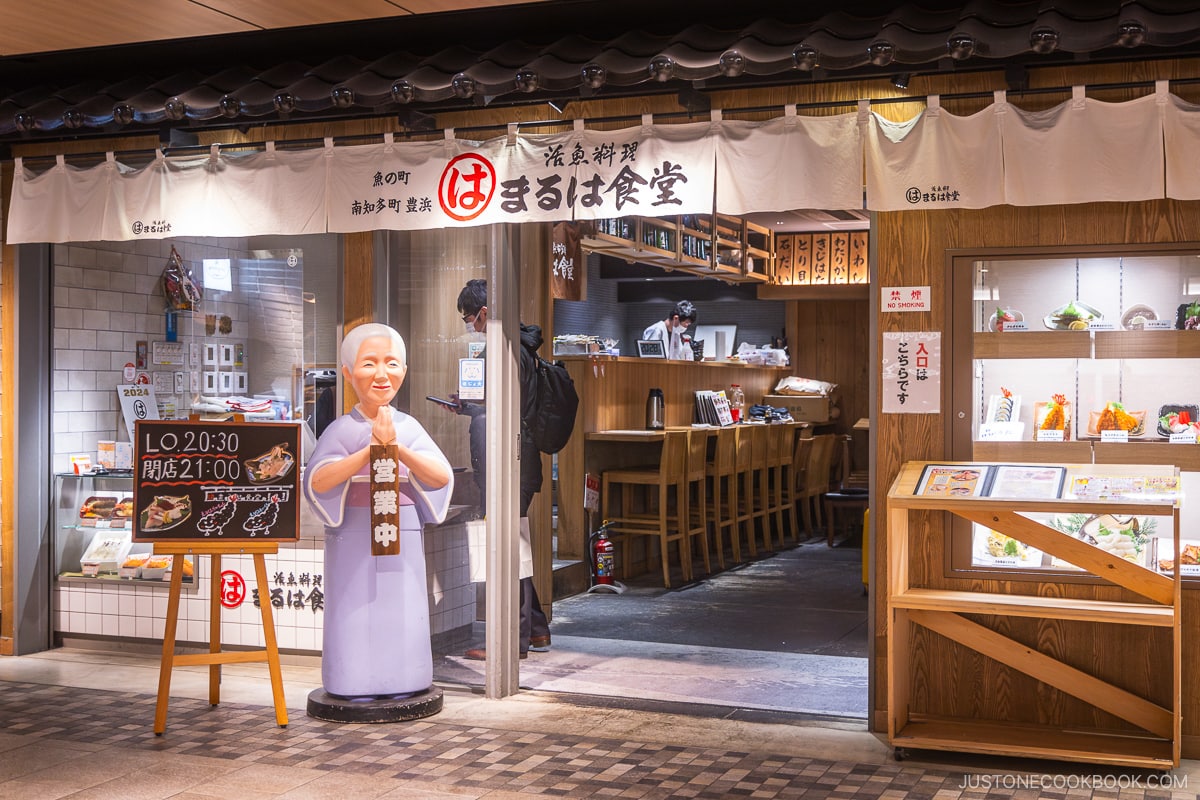
You can find Ebi Fry in izakayas, seafood restaurants, or dedicated shops. Maruha Shokudo is a popular seafood restaurant that offers Ebi Fry Teishoku, allowing you to choose how many pieces of shrimp you want.
The shrimp are huge, each around 15cm long, with a crunchy exterior and meaty interior that’s puri-puri 100%. The dish comes with original tartar sauce, rice, miso soup, and pickles. If you love shrimp, this is the place to go.
Tenmusu (天むす)
Speaking of shrimp, another local specialty is Tenmusu—a rice ball with shrimp tempura. It was founded at Ganso Tenmusu Senju restaurant, which literally translates to ‘the birthplace of tenmusu.’ The original recipe dates back to the 1950s, when a housewife, seeking a convenient meal for her busy husband, combined shrimp tempura with the humble onigiri, thus creating Tenmusu!
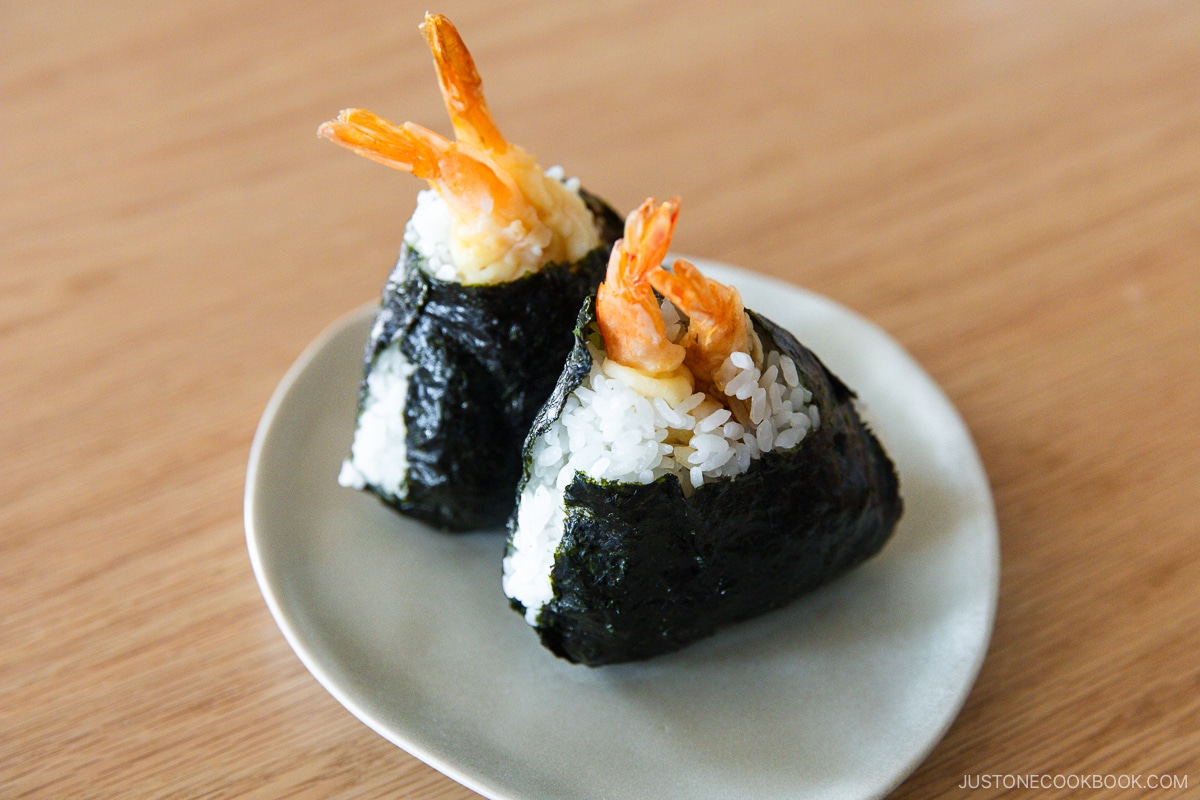
The original restaurant is located in Tsu City, the capital of Mie Prefecture. Due to their popularity, they have opened several other branches in the Nagoya area.
Nagoya Morning (名古屋モーニング)
Nagoya is also famous for its morning menus, with its birthplace said to be Ichinomiya City in north Nagoya. In other parts of Japan, morning meals at restaurants are not very popular, but they are a staple in Nagoya’s food scene.
Throughout the city, you will find countless small kissatens (coffee shops) open in the early morning, serving freshly brewed coffee, toast, and a hard-boiled egg. There are other variations, such as anko (sweet red bean paste) and butter, known as Ogura Toast. The combination of anko and butter is a classic in Japanese cuisine, and with a cup of coffee, you’ll be ready to start your day!
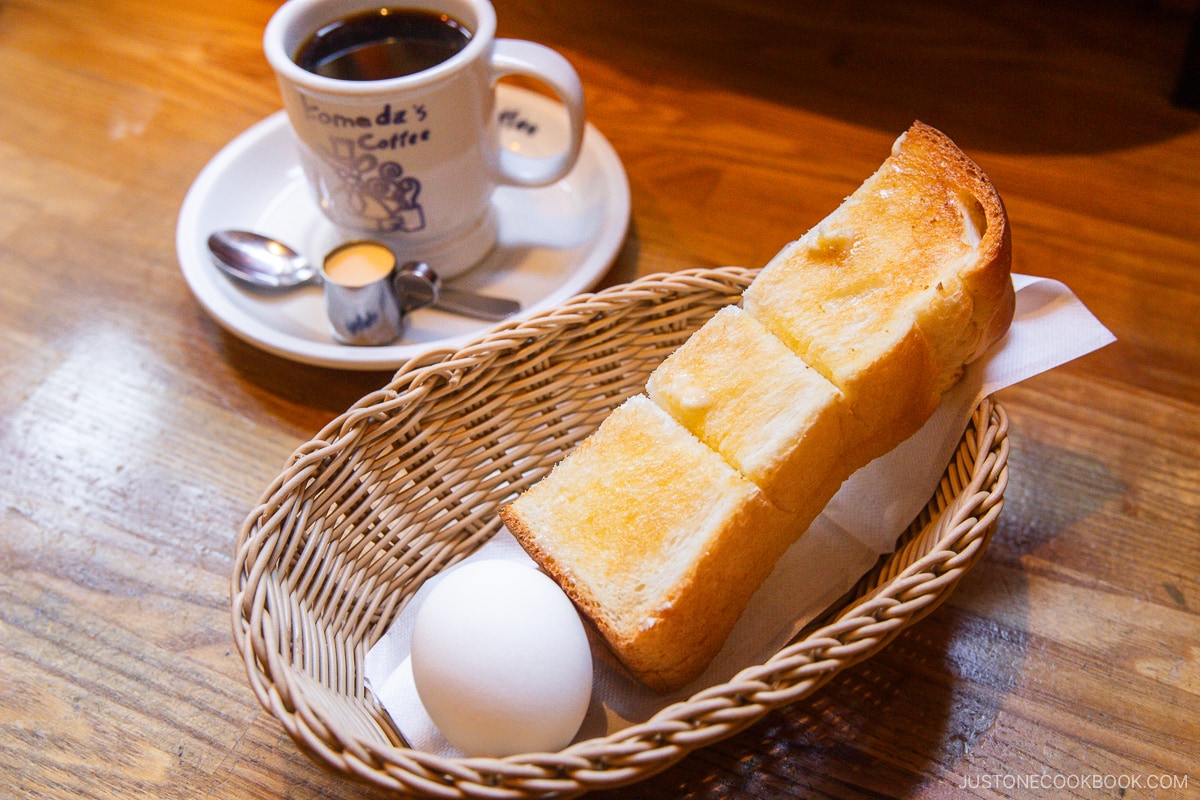
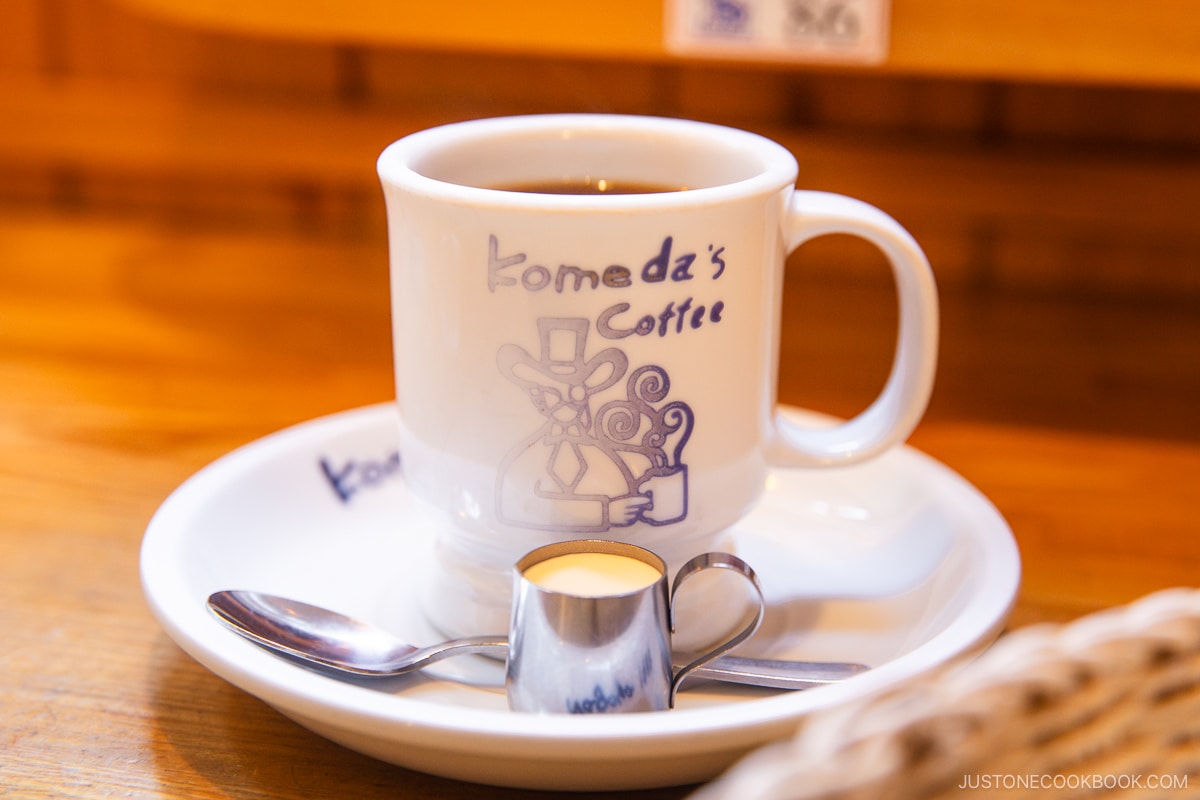
Kissatens are often filled with locals, which can be a little intimidating to enter. If you prefer, head to Komeda Coffee, a kissaten chain, to pick up your Nagoya Morning set!
Here’s a wrap-up of our must-try dishes in Nagoya! When you think of Japanese food, Nagoya doesn’t immediately spring to mind, but we hope that with this guide, you’ll visit and enjoy some of the fantastic food on offer.
Let us know where you want us to cover next in the comments below!

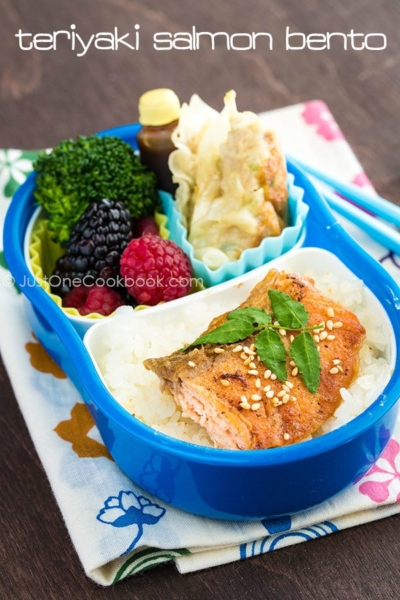
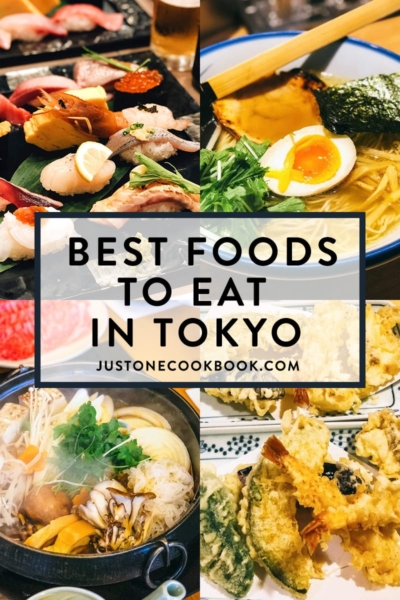
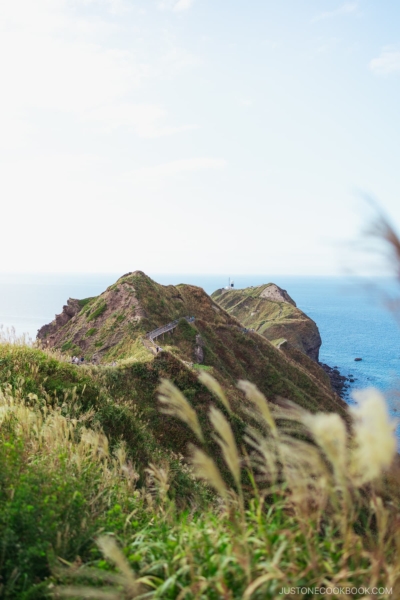
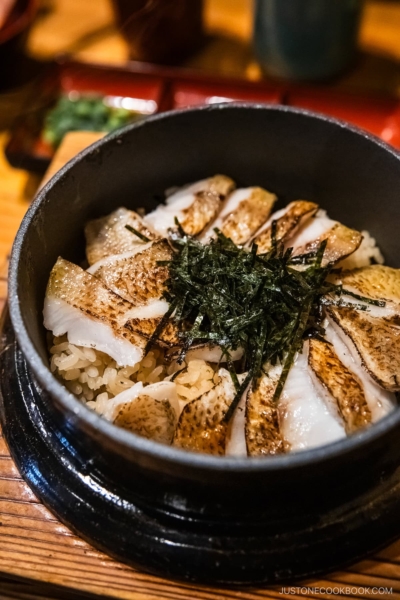




Dear Nami,
Reading over your Nagoya blog brings back a lot of beautiful (and delicious) memories from my trip in 2019. It reminds me a lot of my own trip during the planning phase, as I researched the local specialties and where to have them. While my best meal was a restaurant in the town of Yoshino, there are a 2 places in Nagoya that are not in your list that I strongly recommend.
Miso Katsu – Restaurant name: Tonkatsu Ozeki Main Branch
Address: Japan, 〒453-0024 Aichi, Nagoya, Nakamura Ward, Meirakucho, 1 Chome−6
Comment: Casual dinning, no english. Delicious (I assume common everyday) food. My initial research indicated that Miso Katsu is their speciality. I suspect they used pork belly for their katsu, as there was a nice small cross section of fat which kept the meat extra moist. I’ve had no success replicating this at home though.
Ogura Toast – Cafe name: Hase Coffee
Address: 3 Chome-11-2 Meieki, Nishi Ward, Nagoya, Aichi 451-0045, Japan
Comment: Cosy cafe near my hotel, therefore my opinion could be bias. I found the food/service and decor to be perfect for a relaxed morning wake up call.
Despite being a foreigner, I found both places to serve very comforting food. Please feel free to cross check my suggestions with Google images to see if the above recommendations are suited to your taste.
Regards,
Vernard
Hi Vernard! Thank you so much for your kind feedback and your suggestion! I’ll definitely keep this information and make sure to visit next time I go to Nagoya!
I enjoy reading your posts about your travels and food in Japan. I am planning our family vacation to Japan at the end of this year. Your posts has got me really excited for my trip. Hope to be able to check out these places that you’ve shared. Thanks.
Hi Charmaine! Thank you so much for reading my travel posts! How exciting that you’re going to Japan! Hope my posts are helpful. Have a safe and fun trip to Japan! 🙂
gotta go to Nagoya. I’ve never considered Nagoya, but , i have to go now!!
Hi Carol! It’s a big city, so we never considered to get off the station and sightseeing until this time. We really had a fun 2.5 days! Stay tuned for tourist attraction posts!
Honestly I never had tried fresh wasabi like that, hopefully I will soon when I visit Japan.
Wow, what good eats! And how much fun to meet one of your readers! Interesting read — thanks.
What an informative guide! I really enjoyed your photos and looking at all the different specialities!
Thank you for reading, Diana! So glad you enjoyed this post! 🙂
I should have been more careful not to have read this post while hungry! 🙂 The eel looks so delicious, and the presentation of the set is gorgeous. I had also never heard of chicken skin-wrapped gyoza before, but it sounds like a wonderful comfort food that would be perfect with a cold beer. Thanks for giving us a food tour of some Nagoya staples!
Hi Kimmi! I think I never had chicken skin wrapped gyoza until this trip. It was crispy but a bit oily for my taste. 😀 Thanks so much for always reading my posts!
Always so much fun visiting your blog. Now after my first ever trip to Japan this May. I appreciated it even more. It brought back great memories of my one-day trip. I did eat unagi but at Nagoya Bincho inside ESCA Mall near Nagoya Station. Also had dinner at Yabaton around the Station. Thank you Nami.
Hi Christina! Thank you for reading my post! Happy to hear you enjoyed some Nagoya foods! Hope you’ll like my travel posts for Nagoya too!
Oh I visited my friend who lives in Inuyama last year and she also gave me a crashcourse in Nagoya food.
I really liked Yamachan chicken wings despite not being a wing lover. We also went to Yabuton and ate lots of gohei mochi.
Hi Asami! We didn’t eat Gohei Mochi. Did you like it? The chicken wings are quite addicting, but I was a bit worried about too much MSG and salt being added in the seasoning. 😀 You’re so lucky you have a friend living in Nagoya! Best way to go around the city!
Have never been to Nagoya so the special dishes are new . . . Could eat eel every day: so love both the setup and the order it is meant to be eaten. And the sashimi platter is beautifully set out set out and quite. quite moreish! Have to laugh at the modern presentation of the sake [have quite a liking for that!!] . . .I still use all my old sake sets and this looks SO modern [well, naturally!] . . .
Hi Eha! Nagoya food is very interesting. It has the best of western and eastern Japan foods. 🙂
Haha, yeah maybe this sake setup is for hot and humid summer. Unagi is so delicious. We were so happy trying this dish at a very famous restaurant during our trip!
Hello Nami,
I am so excited to have the ‘little visit’ to Nagoya -it is indeed bittersweet. I miss it and my friends so much. Thank you!
There is one recipe I’ve been trying to find for many many years now. IT is a restaurant pastry shop called Petit Tomato. Both my friend and I have tried, talked with chef, but to no avail! I even wrote to Saveur magazine years ago to try to obtain the recipe for CHESTNUT PIE–well it isn’t an American pie. IT is Japanese Chestnut ! The larding si something like this if I remember corectly–shortbread crust, patisserie cream, Japanese chestnut puree, whipped cream! It is THE best dessert I have EVER eaten. Sadly, I have never ever been able to replicate it. 🙁 If you can help I can send the information to you on specific restaurant location!
You wer so helpful a year and hale ago when my Nagoya friends visited DC at Chrisitmas. . We ordered sushi from your recommendation and had a wonderful meal–one of so many we shared.. I miss them terribly! Last time I was in Nagoya was my birthday 5 years ago & Kyoko surprised me with the chestnut ‘cake’ …BEST birthday I’ve ever had!
Be well, thanks for the wonderful site….Marigail
Isn’t it Mont Blanc cake?
Thank you for answering, Asami! 🙂
Hi Marigail! That’s right, I remember your friends were from Nagoya! Happy to hear you had a fantastic meal. 🙂
Yes, Asami (commenter who responded below you) is right, it’s Mont Blanc. It’s also my mom’s favorite dessert.
I don’t have the recipe, but this one looks good. You’ll need to use Google chrome to translate to English:
http://cookpad.com/recipe/1461119
It’s a delicious treat!
Yummy!
Everything looks so delicious!
This was a great write up, Nami! I really appreciated the photos and your honest comments, and look forward to trying these dishes in Nagoya. In fact, I love miso katsu that I haven’t touched tonkatsu sauce in ages… But I’m the kind of person who enjoys strong tastes (miso ramen, natto). And here’s a tip to readers in Asia: we have Sekai no Yamachan branches in Hong Kong (Tsim Sha Tsui) and in Bangkok (Phrom Phong). I haven’t tried, but I definitely will once I get my braces off.
Hi Kiley! Thank you so much for reading my post already! You like miso katsu! It’s funny how Mr. JOC and I start to enjoy the sauce. We feel like we now have a new recipe (even though it’s just the sauce is different and same Tonkatsu I’m making). We gradually start to enjoy miso katsu. Thanks for letting us know about HK and Bankok branch! Maybe the restaurant might come to the States… 🙂 Hope you get to eat the wings soon! xo